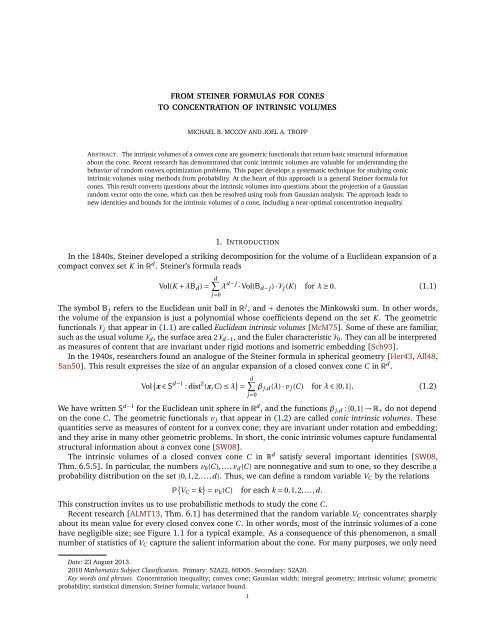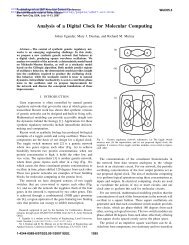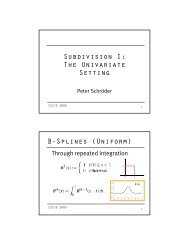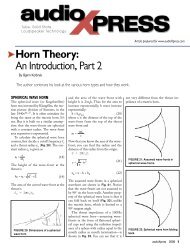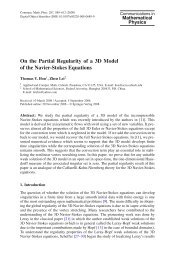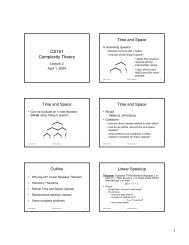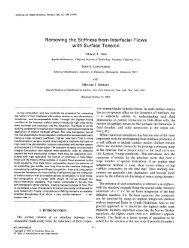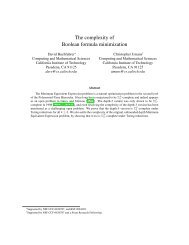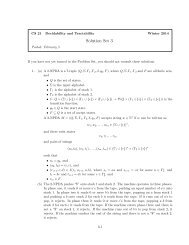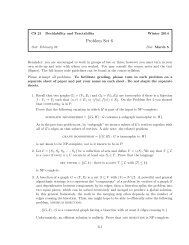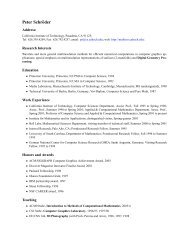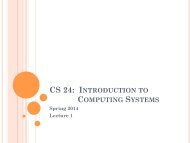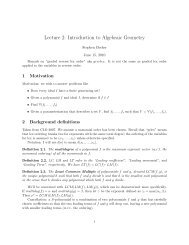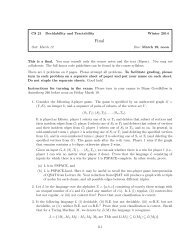From Steiner formulas for cones to concentration of intrinsic volumes
From Steiner formulas for cones to concentration of intrinsic volumes
From Steiner formulas for cones to concentration of intrinsic volumes
Create successful ePaper yourself
Turn your PDF publications into a flip-book with our unique Google optimized e-Paper software.
FROM STEINER FORMULAS FOR CONESTO CONCENTRATION OF INTRINSIC VOLUMESMICHAEL B. MCCOY AND JOEL A. TROPPABSTRACT. The <strong>intrinsic</strong> <strong>volumes</strong> <strong>of</strong> a convex cone are geometric functionals that return basic structural in<strong>for</strong>mationabout the cone. Recent research has demonstrated that conic <strong>intrinsic</strong> <strong>volumes</strong> are valuable <strong>for</strong> understanding thebehavior <strong>of</strong> random convex optimization problems. This paper develops a systematic technique <strong>for</strong> studying conic<strong>intrinsic</strong> <strong>volumes</strong> using methods from probability. At the heart <strong>of</strong> this approach is a general <strong>Steiner</strong> <strong>for</strong>mula <strong>for</strong><strong>cones</strong>. This result converts questions about the <strong>intrinsic</strong> <strong>volumes</strong> in<strong>to</strong> questions about the projection <strong>of</strong> a Gaussianrandom vec<strong>to</strong>r on<strong>to</strong> the cone, which can then be resolved using <strong>to</strong>ols from Gaussian analysis. The approach leads <strong>to</strong>new identities and bounds <strong>for</strong> the <strong>intrinsic</strong> <strong>volumes</strong> <strong>of</strong> a cone, including a near-optimal <strong>concentration</strong> inequality.1. INTRODUCTIONIn the 1840s, <strong>Steiner</strong> developed a striking decomposition <strong>for</strong> the volume <strong>of</strong> a Euclidean expansion <strong>of</strong> acompact convex set K in R d . <strong>Steiner</strong>’s <strong>for</strong>mula readsVol(K + λB d ) =d∑λ d−j · Vol(B d−j ) · V j (K ) <strong>for</strong> λ ≥ 0. (1.1)j =0The symbol B j refers <strong>to</strong> the Euclidean unit ball in R j , and + denotes the Minkowski sum. In other words,the volume <strong>of</strong> the expansion is just a polynomial whose coefficients depend on the set K . The geometricfunctionals V j that appear in (1.1) are called Euclidean <strong>intrinsic</strong> <strong>volumes</strong> [McM75]. Some <strong>of</strong> these are familiar,such as the usual volume V d , the surface area 2V d−1 , and the Euler characteristic V 0 . They can all be interpretedas measures <strong>of</strong> content that are invariant under rigid motions and isometric embedding [Sch93].In the 1940s, researchers found an analogue <strong>of</strong> the <strong>Steiner</strong> <strong>for</strong>mula in spherical geometry [Her43, All48,San50]. This result expresses the size <strong>of</strong> an angular expansion <strong>of</strong> a closed convex cone C in R d .Vol { x ∈ S d−1 : dist 2 (x,C) ≤ λ } =d∑β j,d (λ) · v j (C) <strong>for</strong> λ ∈ [0,1]. (1.2)j =0We have written S d−1 <strong>for</strong> the Euclidean unit sphere in R d , and the functions β j,d : [0,1] → R + do not dependon the cone C. The geometric functionals v j that appear in (1.2) are called conic <strong>intrinsic</strong> <strong>volumes</strong>. Thesequantities serve as measures <strong>of</strong> content <strong>for</strong> a convex cone; they are invariant under rotation and embedding;and they arise in many other geometric problems. In short, the conic <strong>intrinsic</strong> <strong>volumes</strong> capture fundamentalstructural in<strong>for</strong>mation about a convex cone [SW08].The <strong>intrinsic</strong> <strong>volumes</strong> <strong>of</strong> a closed convex cone C in R d satisfy several important identities [SW08,Thm. 6.5.5]. In particular, the numbers v 0 (C),..., v d (C) are nonnegative and sum <strong>to</strong> one, so they describe aprobability distribution on the set {0,1,2,...,d}. Thus, we can define a random variable V C by the relationsP { V C = k } = v k (C)<strong>for</strong> each k = 0,1,2,...,d.This construction invites us <strong>to</strong> use probabilistic methods <strong>to</strong> study the cone C.Recent research [ALMT13, Thm. 6.1] has determined that the random variable V C concentrates sharplyabout its mean value <strong>for</strong> every closed convex cone C. In other words, most <strong>of</strong> the <strong>intrinsic</strong> <strong>volumes</strong> <strong>of</strong> a conehave negligible size; see Figure 1.1 <strong>for</strong> a typical example. As a consequence <strong>of</strong> this phenomenon, a smallnumber <strong>of</strong> statistics <strong>of</strong> V C capture the salient in<strong>for</strong>mation about the cone. For many purposes, we only needDate: 23 August 2013.2010 Mathematics Subject Classification. Primary: 52A22, 60D05. Secondary: 52A20.Key words and phrases. Concentration inequality; convex cone; Gaussian width; integral geometry; <strong>intrinsic</strong> volume; geometricprobability; statistical dimension; <strong>Steiner</strong> <strong>for</strong>mula; variance bound.1
2 M. B. MCCOY AND J. A. TROPP0.0800.06–50.04–100.02–150.000 10 20 30 40 50 60–200 10 20 30 40 50 60FIGURE 1.1: The <strong>intrinsic</strong> <strong>volumes</strong> <strong>of</strong> a circular cone. These two diagrams depict the <strong>intrinsic</strong> <strong>volumes</strong> v k (C)<strong>of</strong> a circular cone C with angle π/6 in R 64 , computed using the <strong><strong>for</strong>mulas</strong> from [Ame11, Ex. 4.4.8]. The <strong>intrinsic</strong>volume random variable V C has mean E[V C ] ≈ 16.5 and variance Var[V C ] ≈ 23.25. The tails <strong>of</strong> V C exhibit Gaussiandecay near the mean and Poisson decay farther away. [left] The <strong>intrinsic</strong> <strong>volumes</strong> v k (C) coincide with theprobability mass function <strong>of</strong> V C . [right] The logarithms log 10 (v k (C)) <strong>of</strong> the <strong>intrinsic</strong> <strong>volumes</strong> have a quadraticpr<strong>of</strong>ile near k = E[V C ], which is indicative <strong>of</strong> the Gaussian decay.<strong>to</strong> know the mean, the variance, and the type <strong>of</strong> tail decay. This paper develops a systematic technique <strong>for</strong>collecting this kind <strong>of</strong> in<strong>for</strong>mation.Our method depends on a generalization <strong>of</strong> the spherical <strong>Steiner</strong> <strong>for</strong>mula (1.2). This result, Theorem 3.1,allows us <strong>to</strong> compute statistics <strong>of</strong> the <strong>intrinsic</strong> volume random variable V C by passing <strong>to</strong> a geometric randomvariable that we can study directly. The prospect <strong>for</strong> making this type <strong>of</strong> argument is dimly visible in the<strong>Steiner</strong> <strong>for</strong>mula (1.2): the right-hand side can be interpreted as a moment <strong>of</strong> V C , while the left-hand sidereflects the probability that a certain geometric event occurs. Our general <strong>Steiner</strong> <strong>for</strong>mula provides theflexibility we need <strong>to</strong> study a wider class <strong>of</strong> statistics.This species <strong>of</strong> argument was proposed by our collabora<strong>to</strong>r Martin Lotz. In our joint paper [ALMT13], weused a laborious version <strong>of</strong> the technique <strong>to</strong> show that the <strong>intrinsic</strong> <strong>volumes</strong> concentrate. Here, we simplifyand strengthen the method <strong>to</strong> obtain new relations <strong>for</strong> the variance <strong>of</strong> V C and <strong>to</strong> improve the <strong>concentration</strong>inequalities. Our work fits in<strong>to</strong> a larger program that studies convex optimization problems with sophisticated<strong>to</strong>ols from geometry; <strong>for</strong> examples, see [VS86, VS92, Don06, BCL08, DT10, BCL10, AB11, AB12a, AB12b,MT12, ALMT13, McC13].1.1. Roadmap. Section 2 contains the definition and basic properties <strong>of</strong> the conic <strong>intrinsic</strong> <strong>volumes</strong>. Section 3states our master <strong>Steiner</strong> <strong>for</strong>mula <strong>for</strong> convex <strong>cones</strong>, and it explains how <strong>to</strong> derive <strong><strong>for</strong>mulas</strong> <strong>for</strong> the size <strong>of</strong> anexpansion <strong>of</strong> a convex cone. We begin our probabilistic analysis <strong>of</strong> the <strong>intrinsic</strong> <strong>volumes</strong> in Section 4. Thismaterial includes <strong><strong>for</strong>mulas</strong> and bounds <strong>for</strong> the variance and exponential moments <strong>of</strong> the <strong>intrinsic</strong> volumerandom variable. Section 5 continues with a probabilistic treatment <strong>of</strong> the <strong>intrinsic</strong> <strong>volumes</strong> <strong>of</strong> a product cone.We provide several detailed examples <strong>of</strong> these methods in Section 6. Afterward, Section 7 summarizes somebackground material about convex <strong>cones</strong> in preparation <strong>for</strong> the pro<strong>of</strong> <strong>of</strong> master <strong>Steiner</strong> <strong>for</strong>mula in Section 8.2. THE INTRINSIC VOLUMES OF A CONVEX CONEWe begin with an introduction <strong>to</strong> the conic <strong>intrinsic</strong> <strong>volumes</strong> that is motivated by the treatment in [Ame11].Our presentation requires some familiarity with the geometry <strong>of</strong> convex <strong>cones</strong>. Check Section 7 <strong>for</strong> anyunexplained terms or notation; we provide cross references whenever possible.Let C d denote the family <strong>of</strong> closed convex <strong>cones</strong> in R d . To each cone <strong>of</strong> this collection, we will assign asequence <strong>of</strong> <strong>intrinsic</strong> <strong>volumes</strong>. For polyhedral <strong>cones</strong>, these functionals have a clear geometric meaning, so westart with the definition <strong>for</strong> this special case.
STEINER FORMULAS FOR CONES AND INTRINSIC VOLUMES 3Definition 2.1 (Intrinsic <strong>volumes</strong> <strong>of</strong> a polyhedral cone). Let C ∈ C d be a polyhedral cone. For k = 0,1,2,...,d,the conic <strong>intrinsic</strong> volume v k (C) is the quantityv k (C) := P { Π C (g ) lies in the relative interior <strong>of</strong> a k-dimensional face <strong>of</strong> C } .The metric projec<strong>to</strong>r Π C on<strong>to</strong> the cone is defined in (7.1), and the random vec<strong>to</strong>r g ∼ NORMAL(0,I) is drawnfrom the standard normal distribution on R d .As Section 7.5 will explain, we can equip the set C d with the conic Hausdorff metric <strong>to</strong> <strong>for</strong>m a compactmetric space. The polyhedral <strong>cones</strong> <strong>for</strong>m a dense subset <strong>of</strong> C d , so it is natural <strong>to</strong> use approximation <strong>to</strong> extendthe definition <strong>of</strong> the <strong>intrinsic</strong> <strong>volumes</strong> <strong>to</strong> nonpolyhedral <strong>cones</strong>.Definition 2.2 (Intrinsic <strong>volumes</strong> <strong>of</strong> a closed convex cone). Let C ∈ C d be a closed convex cone. Consider anysequence (C i ) i∈N <strong>of</strong> polyhedral <strong>cones</strong> in C d where C i → C in the conic Hausdorff metric. Definev k (C) := limi→∞v k (C i ) <strong>for</strong> k = 0,1,2,...,d. (2.1)The geometric functionals v k : C d → [0,1] are called conic <strong>intrinsic</strong> <strong>volumes</strong>.See Section 8.2 <strong>for</strong> a pro<strong>of</strong> that the limit in (2.1) is well defined. The reader should be aware that thegeometric interpretation <strong>of</strong> <strong>intrinsic</strong> <strong>volumes</strong> from Definition 2.1 breaks down <strong>for</strong> general <strong>cones</strong> because thelimiting process does not preserve facial structure.The conic <strong>intrinsic</strong> <strong>volumes</strong> have some remarkable properties. Fix the ambient dimension d, and let C ∈ C dbe a closed convex cone in R d . The <strong>intrinsic</strong> <strong>volumes</strong> are...(1) Intrinsic. The <strong>intrinsic</strong> <strong>volumes</strong> do not depend on the dimension <strong>of</strong> the space R d in which the coneC is embedded. That is, <strong>for</strong> each natural number r ,{vk (C), 0 ≤ k ≤ dv k (C × {0 r }) =0, d < k ≤ d + r.(2) Volumes. Let γ d denote the standard normal measure on R d . Then v d (C) = γ d (C) and v 0 (C) = γ d (C ◦ )where C ◦ denotes the polar cone. The other <strong>intrinsic</strong> <strong>volumes</strong>, however, do not admit such a clearinterpretation.(3) Rotation invariant. For each d × d orthogonal matrix Q, we have v k (QC) = v k (C).(4) A distribution. The <strong>intrinsic</strong> <strong>volumes</strong> <strong>for</strong>m a probability distribution on {0,1,2,...,d}. That is,v k (C) ≥ 0andd∑v j (C) = 1.(5) Indica<strong>to</strong>rs <strong>of</strong> dimension <strong>for</strong> a subspace. For any j-dimensional subspace L j ⊂ R d , we have{1, k = jv k (L j ) =0, k ≠ j.(6) Reversed under polarity. The <strong>intrinsic</strong> <strong>volumes</strong> <strong>of</strong> the polar cone C ◦ satisfyj =0v k (C ◦ ) = v d−k (C).These claims follow from Definition 2.2 using facts from Section 7 about the geometry <strong>of</strong> convex <strong>cones</strong>.Remark 2.3 (Notation <strong>for</strong> <strong>intrinsic</strong> <strong>volumes</strong>). The notation v k <strong>for</strong> the kth <strong>intrinsic</strong> volume does not specifythe ambient dimension. This convention is justified because the <strong>intrinsic</strong> <strong>volumes</strong> <strong>of</strong> a cone do not depend onthe embedding dimension.3. A GENERALIZED STEINER FORMULA FOR CONESAs we have seen, the <strong>intrinsic</strong> <strong>volumes</strong> <strong>of</strong> a cone <strong>for</strong>m a probability distribution. Probabilistic methods <strong>of</strong>fera powerful technique <strong>for</strong> studying the <strong>intrinsic</strong> <strong>volumes</strong>. To pursue this idea, we want access <strong>to</strong> momentsand other statistics <strong>of</strong> the sequence <strong>of</strong> <strong>intrinsic</strong> <strong>volumes</strong>. We acquire this in<strong>for</strong>mation using a general <strong>Steiner</strong><strong>for</strong>mula <strong>for</strong> <strong>cones</strong>.
4 M. B. MCCOY AND J. A. TROPP3.1. The master <strong>Steiner</strong> <strong>for</strong>mula. Let us introduce a class <strong>of</strong> Gaussian integrals. Fix a Borel measurablebivariate function f : R 2 + → R. Consider the geometric functionalϕ f : C d → R where ϕ f (C) := E [ f ( ‖Π C (g )‖ 2 , ‖Π C ◦(g )‖ 2 )] . (3.1)Throughout the paper, we reserve the letter g <strong>for</strong> a standard normal random vec<strong>to</strong>r whose dimension isdetermined by context, and all expectations are interpreted as Lebesgue integrals. We can develop an elegantexpansion <strong>of</strong> ϕ f in terms <strong>of</strong> the conic <strong>intrinsic</strong> <strong>volumes</strong>.Theorem 3.1 (Master <strong>Steiner</strong> <strong>for</strong>mula <strong>for</strong> <strong>cones</strong>). Let f : R 2 + → R be a Borel measurable function. Then thegeometric functional ϕ f defined in (3.1) admits the expressionϕ f (C) =d∑ϕ f (L k ) · v k (C) <strong>for</strong> C ∈ C d (3.2)k=0provided that all the expectations in (3.2) are finite. Here, L k denotes a k-dimensional subspace <strong>of</strong> R d and theconic <strong>intrinsic</strong> <strong>volumes</strong> v k are introduced in Definition 2.2.The coefficients ϕ f (L k ) in the expression (3.2) have an alternative <strong>for</strong>m that is convenient <strong>for</strong> computations.Let L k be an arbitrary k-dimensional subspace <strong>of</strong> R d . According <strong>to</strong> the definition (3.1) <strong>of</strong> the functional ϕ f ,ϕ f (L k ) = E [ f ( ‖Π Lk (g )‖ 2 , ‖Π Lk◦(g )‖ 2 )] .The marginal property <strong>of</strong> the standard normal vec<strong>to</strong>r g ensures that Π Lk (g ) and Π Lk◦(g ) are independentstandard normal vec<strong>to</strong>rs supported on L k and L k ◦ . Thus, ‖Π Lk (g )‖ 2 and ‖Π Lk◦(g )‖ 2 are independent chi-squarerandom variables with k and d − k degrees <strong>of</strong> freedom respectively. Note the convention that a chi-squarevariable with zero degrees <strong>of</strong> freedom is identically zero. In view <strong>of</strong> this fact, we have the following equivalen<strong>to</strong>f Theorem 3.1.Corollary 3.2. Instate the hypotheses and notation <strong>of</strong> Theorem 3.1. Let { X 0 ,..., X d} be an independent sequence<strong>of</strong> random variables where X k has the chi-square distribution with k degrees <strong>of</strong> freedom, and let { X ′ 0 ,..., X ′ d} bean independent copy <strong>of</strong> this sequence. Thenϕ f (C) =d∑E [ f ( X k, Xd−k)] ′ · vk (C) <strong>for</strong> C ∈ C d .k=0Corollary 3.2 has an appealing probabilistic consequence. For every cone C ∈ C d , the random variable‖Π C (g )‖ 2 is a mixture <strong>of</strong> chi-square random variables X 0 ,..., X d where the mixture coefficients v k (C) aredetermined solely by the cone.We outline the pro<strong>of</strong> <strong>of</strong> Theorem 3.1 in Sections 7 and 8. The argument involves techniques that arealready familiar <strong>to</strong> experts. Many <strong>of</strong> the core ideas appear in McMullen’s influential paper [McM75]. Asimilar approach has been used in hyperbolic integral geometry [San80, p. 242]; see also the pro<strong>of</strong> <strong>of</strong> [SW08,Thm. 6.5.1]. The only technical novelty is our method <strong>for</strong> showing that the conic <strong>intrinsic</strong> <strong>volumes</strong> arecontinuous with respect <strong>to</strong> the conic Hausdorff metric.3.2. How big is the expansion <strong>of</strong> a cone? The Euclidean <strong>Steiner</strong> <strong>for</strong>mula (1.1) describes the volume <strong>of</strong> aEuclidean expansion <strong>of</strong> a compact convex set. Although it may not be obvious from the identity (3.2), themaster <strong>Steiner</strong> <strong>for</strong>mula contains in<strong>for</strong>mation about the volume <strong>of</strong> an expansion <strong>of</strong> a convex cone. This sectionexplains the connection, which justifies our decision <strong>to</strong> call Theorem 3.1 a <strong>Steiner</strong> <strong>for</strong>mula.First, we argue that there is a simple expression <strong>for</strong> the Gaussian measure <strong>of</strong> a Euclidean expansion <strong>of</strong> aconvex cone.Proposition 3.3 (Gaussian <strong>Steiner</strong> <strong>for</strong>mula). For each cone C ∈ C d and each number λ ≥ 0,γ d (C + λB d ) = P { dist 2 (g ,C) ≤ λ } =d∑P { X d−k ≤ λ } · v k (C) (3.3)where γ d is the standard normal measure on R d and B d is the unit ball in R d . The random variable X k followsthe chi-square distribution with k degrees <strong>of</strong> freedom.k=0
STEINER FORMULAS FOR CONES AND INTRINSIC VOLUMES 5Pro<strong>of</strong>. The first identity in (3.3) is immediate. For the second, we appeal <strong>to</strong> Corollary 3.2 with the function{1, b ≤ λf (a,b) =0, otherwise.This step yields the relationP { dist 2 (g ,C) ≤ λ } = P { ‖Π C ◦(g )‖ 2 ≤ λ } =d∑E [ f ( X k , X ′ )] d∑d−k = P { X ′ d−k ≤ λ} · v k (C).k=0The first equality depends on the representation (7.3) <strong>of</strong> the distance <strong>to</strong> a cone in terms <strong>of</strong> the metric projec<strong>to</strong>ron<strong>to</strong> the polar cone. The result (3.3) follows because X ′ d−k has the same distribution as X d−k.□We can also establish the spherical <strong>Steiner</strong> <strong>for</strong>mula (1.2) as a consequence <strong>of</strong> Theorem 3.1 by replacing theGaussian vec<strong>to</strong>r g in Proposition 3.3 with a random vec<strong>to</strong>r θ that is uni<strong>for</strong>mly distributed on the Euclideanunit sphere. This strategy leads <strong>to</strong> an expression <strong>for</strong> the proportion <strong>of</strong> the sphere subtended by an angularexpansion <strong>of</strong> the cone.Proposition 3.4 (Spherical <strong>Steiner</strong> <strong>for</strong>mula). For each cone C ∈ C d and each number λ ∈ [0,1], it holds thatP { dist 2 (θ,C) ≤ λ } =k=0d∑P { B d−k,d ≤ λ } · v k (C). (3.4)k=0The random vec<strong>to</strong>r θ is drawn from the uni<strong>for</strong>m distribution on the unit sphere S d−1 in R d , and the randomvariable B j,d follows the ( 1BETA2 j, 12 d) distribution.Pro<strong>of</strong>. When λ = 1, both sides <strong>of</strong> (3.4) equal one. For λ < 1, we convert the spherical variable <strong>to</strong> a Gaussianusing the relation θ ∼ g /‖g ‖ where ∼ denotes equality <strong>of</strong> distribution. It follows thatP { dist 2 (θ,C) ≤ λ } = P { ‖Π C ◦(g )‖ 2 ≤ λ(1 − λ) −1 · ‖Π C (g )‖ 2 } .This identity depends on the representation (7.3) <strong>of</strong> the distance, the nonnegative homogeneity <strong>of</strong> the metricprojec<strong>to</strong>r Π C ◦, and the Pythagorean relation (7.4). Apply Corollary 3.2 with the function{1, b ≤ λ(1 − λ) −1 af (a,b) =0, otherwise.To finish, we recall the geometric interpretation [Art02] <strong>of</strong> the beta random variable: B j,d ∼ ‖Π L j(θ)‖ 2 whereL j is a j-dimensional subspace <strong>of</strong> R d .□4. PROBABILISTIC ANALYSIS OF INTRINSIC VOLUMESIn this section, we sic probabilistic methods on the conic <strong>intrinsic</strong> <strong>volumes</strong>. Our main <strong>to</strong>ol is the master<strong>Steiner</strong> <strong>for</strong>mula, Theorem 3.1, which we use repeatedly <strong>to</strong> convert statements about the <strong>intrinsic</strong> <strong>volumes</strong> <strong>of</strong> acone in<strong>to</strong> statements about the projection <strong>of</strong> a Gaussian vec<strong>to</strong>r on<strong>to</strong> the cone. We may then apply methodsfrom Gaussian analysis <strong>to</strong> study this random variable.4.1. The <strong>intrinsic</strong> volume random variable. Definitions 2.1 and 2.2 make it clear that the <strong>intrinsic</strong> <strong>volumes</strong><strong>for</strong>m a probability distribution. This observation suggests that it would be fruitful <strong>to</strong> analyze the <strong>intrinsic</strong><strong>volumes</strong> using techniques from probability. We begin with the key definition.Definition 4.1 (Intrinsic volume random variable). Let C ∈ C d be a closed convex cone. The <strong>intrinsic</strong> volumerandom variable V C has the distributionP { V C = k } = v k (C)<strong>for</strong> k = 0,1,2,...,d.Notice that the <strong>intrinsic</strong> volume random variable <strong>of</strong> a cone C ∈ C d and its polar have a tight relationship:P { V C ◦ = k } = v k (C ◦ ) = v d−k (C)because polarity reverses the sequence <strong>of</strong> <strong>intrinsic</strong> <strong>volumes</strong>. In other words, V C ◦ ∼ d −V C .
6 M. B. MCCOY AND J. A. TROPP4.2. The statistical dimension <strong>of</strong> a cone. The expected value <strong>of</strong> the <strong>intrinsic</strong> volume random variable V Chas a distinguished place in the theory because V C concentrates sharply about this point. In anticipation <strong>of</strong>this result, we glorify the expectation <strong>of</strong> V C with its own name and notation.Definition 4.2 (Statistical dimension [ALMT13, Sec. 5.3]). The statistical dimension δ(C) <strong>of</strong> a cone C ∈ C d isthe quantityd∑δ(C) := E[V C ] = k v k (C).The statistical dimension <strong>of</strong> a cone really is a measure <strong>of</strong> its dimension. In particular,k=0δ(L) = dim(L) <strong>for</strong> each subspace L ⊂ R d . (4.1)In fact, the statistical dimension is the canonical extension <strong>of</strong> the dimension <strong>of</strong> a subspace <strong>to</strong> the class <strong>of</strong>convex <strong>cones</strong> [ALMT13, Sec. 5.3]. By this, we mean that the statistical dimension is the only rotation invariant,continuous valuation on C d that satisfies (4.1) and that is localizable. See [SW08, p. 254 and Thm. 6.5.4] <strong>for</strong>further in<strong>for</strong>mation about the unexplained technical terms.The statistical dimension interacts beautifully with the polarity operation. In particular,δ(C) + δ(C ◦ ) = E[V C ] + E[V C ◦] = E[V C ] + E[d −V C ] = d.This <strong>for</strong>mula allows us <strong>to</strong> evaluate the statistical dimension <strong>of</strong> an important class <strong>of</strong> <strong>cones</strong>. A closed convexcone C is self-dual when it satisfies the identity C = −C ◦ . Examples include the nonnegative orthant, thesecond-order cone, and the cone <strong>of</strong> positive-semidefinite matrices. We haveδ(C) = 1 2 d <strong>for</strong> a self-dual cone C ∈ C d. (4.2)The statistical dimension <strong>of</strong> a cone can be expressed in terms <strong>of</strong> the projection <strong>of</strong> a normal random vec<strong>to</strong>ron<strong>to</strong> the cone [ALMT13, Prop. 5.11]. The master <strong>Steiner</strong> <strong>for</strong>mula gives an easy pro<strong>of</strong> <strong>of</strong> this result.Proposition 4.3 (Statistical dimension). Let C ∈ C d be a closed convex cone. Thenδ(C) = E [ ‖Π C (g )‖ 2 ] .The identity in Proposition 4.3 can be used <strong>to</strong> evaluate the statistical dimension <strong>for</strong> many <strong>cones</strong> <strong>of</strong> interest.See [ALMT13, Sec. 4] <strong>for</strong> details and examples.Pro<strong>of</strong>. The master <strong>Steiner</strong> <strong>for</strong>mula, Corollary 3.2, with function f (a,b) = a states thatE [ ‖Π C (g )‖ 2 ] d∑= E [ ] d∑X k · vk (C) = k v k (C) = δ(C).Indeed, a chi-square variable X k with k degrees <strong>of</strong> freedom has expectation k.k=04.3. The variance <strong>of</strong> the <strong>intrinsic</strong> <strong>volumes</strong>. The variance <strong>of</strong> the <strong>intrinsic</strong> volume random variable tells ushow tightly the <strong>intrinsic</strong> <strong>volumes</strong> cluster around their mean value. We can find an explicit expression <strong>for</strong> thevariance in terms <strong>of</strong> the projection <strong>of</strong> a Gaussian vec<strong>to</strong>r on<strong>to</strong> the cone.Proposition 4.4 (Variance <strong>of</strong> the <strong>intrinsic</strong> <strong>volumes</strong>). Let C ∈ C d be a closed convex cone. Thenk=0Var[V C ] = Var [ ‖Π C (g )‖ 2 ] − 2δ(C) (4.3)= Var [ ‖Π C ◦(g )‖ 2 ] − 2δ(C ◦ ) = Var[V C ◦]. (4.4)Proposition 4.4 leads <strong>to</strong> exact <strong><strong>for</strong>mulas</strong> <strong>for</strong> the variance <strong>of</strong> the <strong>intrinsic</strong> volume sequence in severalinteresting cases; Section 6 contains some worked examples.Pro<strong>of</strong>. By definition, the variance satisfiesVar[V C ] = E [ V 2 C]−(E[VC ] ) 2 = E[V2C]− δ(C) 2 .To obtain the expectation <strong>of</strong> V 2 C, we invoke the master <strong>Steiner</strong> <strong>for</strong>mula, Corollary 3.2, with the functionf (a,b) = a 2 <strong>to</strong> obtainE [ ‖Π C (g )‖ 4 ] d∑= E [ X 2 ] d∑d∑k · vk (C) = k 2 v k (C) + 2 k v k (C) = E [ V 2 ]C + 2δ(C).k=0k=0k=0□
STEINER FORMULAS FOR CONES AND INTRINSIC VOLUMES 7Indeed, the raw second moment <strong>of</strong> a chi-square random variable X k with k degrees <strong>of</strong> freedom equals k 2 + 2k.Combine these two displays <strong>to</strong> reachVar[V C ] = E [ ‖Π C (g )‖ 4 ] − δ(C) 2 − 2δ(C) = E [ ‖Π C (g )‖ 4 ] − ( E [ ‖Π C (g )‖ 2 ]) 2 − 2δ(C)where the second identity follows from Proposition 4.3. Identify the variance <strong>of</strong> ‖Π C (g )‖ 2 <strong>to</strong> complete thepro<strong>of</strong> <strong>of</strong> (4.3). To establish (4.4), note that Var[V C ] = Var[d − V C ] = Var[V C ◦], and then apply (4.3) <strong>to</strong> therandom variable V C ◦.□4.4. A bound <strong>for</strong> the variance <strong>of</strong> the <strong>intrinsic</strong> <strong>volumes</strong>. Proposition 4.4 also allows us <strong>to</strong> produce a generalbound on the variance <strong>of</strong> the <strong>intrinsic</strong> <strong>volumes</strong> <strong>of</strong> a cone.Theorem 4.5 (Variance bound <strong>for</strong> <strong>intrinsic</strong> <strong>volumes</strong>). Let C ∈ C d be a closed convex cone. ThenThe opera<strong>to</strong>r ∧ returns the minimum <strong>of</strong> two numbers.Var[V C ] ≤ 2 ( δ(C) ∧ δ(C ◦ ) ) .The example in Section 6.3 demonstrates that the constant two in (4.5) cannot be reduced.Pro<strong>of</strong>. To bound the variance <strong>of</strong> V C , we plan <strong>to</strong> invoke the Gaussian Poincaré inequality [Bog98, Thm. 1.6.4]<strong>to</strong> control the variance <strong>of</strong> ‖Π C (g )‖ 2 . This inequality states thatVar[H(g )] ≤ E [ ‖∇H(g )‖ 2 ] .<strong>for</strong> any function H : R d → R whose gradient is square-integrable with respect <strong>to</strong> the standard normal measure.We apply this result <strong>to</strong> the functionH(x) = ‖Π C (x)‖ 2 with ‖∇H(x)‖ 2 = 4‖Π C (x)‖ 2 .The gradient calculation is justified by (7.5). We determine thatVar [ ‖Π C (g )‖ 2 ] ≤ 4E [ ‖Π C (g )‖ 2 ] = 4δ(C)where the second identity follows from Proposition 4.3. Introduce this inequality in<strong>to</strong> (4.3) <strong>to</strong> see thatVar[V C ] ≤ 2δ(C). We can apply the same argument <strong>to</strong> see thatVar [ ‖Π C ◦(g )‖ 2 ] ≤ 4δ(C ◦ ).Substitute this bound in<strong>to</strong> (4.4) <strong>to</strong> conclude that Var[V C ] ≤ 2δ(C ◦ ).In principle, a random variable taking values in {0,1,2,...,d} can have variance larger than d 2 /3—considerthe uni<strong>for</strong>m random variable. In contrast, Theorem 4.5 tells us that the variance <strong>of</strong> the <strong>intrinsic</strong> volumerandom variable V C cannot exceed d <strong>for</strong> any cone C. This observation has consequences <strong>for</strong> the tail behavior<strong>of</strong> V C . Indeed, Chebyshev’s inequality implies that{P |V C − δ(C)| > λ √ }δ(C)≤ Var[V C ]λ 2 δ(C) ≤ 2 λ 2 .That is, most <strong>of</strong> the mass <strong>of</strong> V C is located near the statistical dimension.4.5. Exponential moments <strong>of</strong> the <strong>intrinsic</strong> <strong>volumes</strong>. In the previous section, we discovered that the<strong>intrinsic</strong> volume random variable V C is <strong>of</strong>ten close <strong>to</strong> its mean value. This observation suggests that V Cmight exhibit stronger <strong>concentration</strong>. A standard method <strong>for</strong> proving <strong>concentration</strong> inequalities <strong>for</strong> a randomvariable is <strong>to</strong> calculate its exponential moments. The master <strong>Steiner</strong> <strong>for</strong>mula allows us <strong>to</strong> accomplish this task.Proposition 4.6 (Exponential moments <strong>of</strong> the <strong>intrinsic</strong> <strong>volumes</strong>). Let C ∈ C d be a closed convex cone. For eachparameter ζ ∈ R,Ee ζV C= Ee ξ‖Π C (g )‖ 2 where ξ = 1 2(1 − e−2ζ ) .Pro<strong>of</strong>. Fix a number ξ < 1 2 . With the choice f (a,b) = eξa , Corollary 3.2 shows thatd∑Ee ξ‖Π C (g )‖ 2 [ ] d∑d∑= EeξX k · vk (C) = (1 − 2ξ) −k/2 v k (C) = e ζk v k (C) = Ee ζV C.k=0k=0We have used the familiar <strong>for</strong>mula <strong>for</strong> the exponential moments <strong>of</strong> a chi-square random variable X k with kdegrees <strong>of</strong> freedom. The penultimate identity follows from the change <strong>of</strong> variables ζ = − 1 2log(1 − 2ξ), whichestablishes a bijection between ξ < 1 2and ζ ∈ R.□k=0□
8 M. B. MCCOY AND J. A. TROPPRemark 4.7 (Conic Wills functional). Proposition 4.6 leads <strong>to</strong> a geometric description <strong>of</strong> the generatingfunction <strong>of</strong> the <strong>intrinsic</strong> <strong>volumes</strong>:( 1 − λW C (λ) := λ d 2) d∑Eexp · dist 2 (g ,C) = λ k v k (C) <strong>for</strong> λ > 0. (4.5)2To see why this is true, use the representation (7.3) <strong>of</strong> the distance, and apply Proposition 4.6 with ζ = −logλ<strong>to</strong> confirm that( 1 − λW C (λ) = λ d 2)Eexp · ‖Π C ◦(g )‖ 2 = λ d ∑ d d∑λ −k v k (C ◦ ) = λ k v k (C).2We have applied the fact that polarity reverses <strong>intrinsic</strong> <strong>volumes</strong> <strong>to</strong> reindex the sum. The function W C can beviewed as a conic analog <strong>of</strong> the Wills functional [Wil73] from Euclidean geometry.4.6. A bound <strong>for</strong> the exponential moments <strong>of</strong> the <strong>intrinsic</strong> <strong>volumes</strong>. Proposition 4.6 allows us <strong>to</strong> obtainan excellent bound <strong>for</strong> the exponential moments <strong>of</strong> V C . In the next section, we use this result <strong>to</strong> develop<strong>concentration</strong> inequalities <strong>for</strong> the <strong>intrinsic</strong> <strong>volumes</strong>.Theorem 4.8 (Exponential moment bound <strong>for</strong> <strong>intrinsic</strong> <strong>volumes</strong>). Let C ∈ C d be a closed convex cone. For eachparameter ζ ∈ R,()Ee ζ(V C −δ(C)) e 2ζ − 2ζ − 1≤ exp· δ(C) , and (4.6)2()Ee ζ(V C −δ(C)) e −2ζ + 2ζ − 1≤ exp· δ(C ◦ ) . (4.7)2The major technical challenge is <strong>to</strong> bound the exponential moments <strong>of</strong> the random variable ‖Π C (g )‖ 2 .The following lemma provides a sharp estimate <strong>for</strong> the exponential moments. It improves on an earlierresult [ALMT13, Sublem. D.3].Lemma 4.9. Let C ∈ C d be a closed convex cone. For each parameter ξ < 1 2 ,(Ee ξ(‖Π C (g )‖ 2 2ξ −δ(C)) 2 )δ(C)≤ exp .1 − 2ξPro<strong>of</strong>. Define the zero-mean random variablek=0k=0Z := ‖Π C (g )‖ 2 − δ(C).Introduce the moment generating function m(ξ) := Ee ξZ . Our aim is <strong>to</strong> bound m(ξ). Be<strong>for</strong>e we begin, it ishelpful <strong>to</strong> note a few properties <strong>of</strong> the moment generating function. First, the derivative m ′ (ξ) = E[Z e ξZ ] wheneverξ < 1 2 . By direct calculation, logm(0) = 0. Furthermore, l’Hôpital’s rule shows that lim ξ→0 ξ −1 logm(ξ) = 0because the random variable Z has zero mean.The argument is based on the Gaussian logarithmic Sobolev inequality [Bog98, Thm. 1.6.1]. One version<strong>of</strong> this result states thatE [ H(g ) · e H(g )] − E [ e H(g )] log E [ e H(g )] ≤ 1 2 E[ ‖∇H(g )‖ 2 · e H(g )] (4.8)<strong>for</strong> any differentiable function H : R d → R such that the expectations in (4.8) are finite. We apply this result <strong>to</strong>the functionH(x) = ξ [ ‖Π C (x)‖ 2 − δ(C) ] with ‖∇H(x)‖ = 4ξ 2 ‖Π C (x)‖ 2 .The gradient calculation is justified by (7.5). Notice thatH(g ) = ξZ and ‖∇H(g )‖ 2 = 4ξ 2 (Z + δ(C)).There<strong>for</strong>e, the logarithmic Sobolev inequality (4.8) delivers the relationξ · E [ Z e ξZ ] − E [ e ξZ ] log E [ e ξZ ] ≤ 2ξ 2 · E [ Z e ξZ ] + 2ξ 2 δ(C) · E [ e ξZ ] <strong>for</strong> ξ < 1 2 .We can rewrite the last display as a differential inequality <strong>for</strong> the moment generating function:ξm ′ (ξ) − m(ξ)logm(ξ) ≤ 2ξ 2 m ′ (ξ) + 2δ(C) · ξ 2 m(ξ) <strong>for</strong> ξ < 1 2 . (4.9)The requirement on ξ is necessary and sufficient <strong>to</strong> ensure that m(ξ) and m ′ (ξ) are finite. To complete thepro<strong>of</strong>, we just need <strong>to</strong> solve this differential inequality.k=0
STEINER FORMULAS FOR CONES AND INTRINSIC VOLUMES 9We follow the argument from [BLM03, Thm. 5]. Divide the inequality (4.9) by the positive number ξ 2 m(ξ)<strong>to</strong> reach1ξ · m′ (ξ)m(ξ) − 1 ξ 2 logm(ξ) ≤ 2 · m′ (ξ)m(ξ) + 2δ(C) <strong>for</strong> ξ ∈ (−∞,0) ∪ ( 0, 1 )2 .The left- and right-hand sides <strong>of</strong> this relation are exactly integrable:[ ]d 1ds s logm(s) ≤ 2 · d [ ]logm(s) + 2δ(C) · s <strong>for</strong> s ∈ (−∞,0) ∪ ( 0, 1 )ds2 . (4.10)To continue, we first consider the case 0 < ξ < 1 2. Integrate the inequality (4.10) over the interval s ∈ [0,ξ]using the boundary conditions logm(0) = 0 and lim ξ→0 ξ −1 logm(ξ) = 0. This step yields1ξ logm(ξ) ≤ 2logm(ξ) + 2δ(C) · ξ <strong>for</strong> 0 < ξ < 1 2 .Solve this relation <strong>for</strong> the moment generating function m <strong>to</strong> obtain the bound( 2ξ 2 )δ(C)m(ξ) ≤ exp<strong>for</strong> 0 ≤ ξ < 11 − 2ξ2 . (4.11)The boundary case ξ = 0 follows from a direct calculation. Next, we address the situation where ξ < 0.Integrating (4.10) over the interval [ξ,0], we find that− 1 logm(ξ) ≤ −2logm(ξ) − 2δ(C) · ξ <strong>for</strong> ξ < 0.ξSolve this inequality <strong>for</strong> m <strong>to</strong> see that the bound (4.11) also holds in the range ξ < 0. This observationcompletes the pro<strong>of</strong>.□With Lemma 4.9 at hand, we quickly reach Theorem 4.8.Pro<strong>of</strong> <strong>of</strong> Theorem 4.8. We begin with the statement from Proposition 4.6. Adding and subtracting multiples <strong>of</strong>δ(C) in the exponent, we obtain the relationEe ζ(V C −δ(C)) = e (ξ−ζ)δ(C) · Ee ξ(‖Π C (g )‖ 2 −δ(C)) .where ξ = 1 (2 1 − e−2ζ ) < 1 2. Lemma 4.9 controls the moment generating function on the right-hand side:(Ee ζ(V C 2ξ −δ(C)) ≤ e (ξ−ζ)δ(C) 2 )δ(C)· exp .1 − 2ξBy a marvelous coincidence, the terms in the exponent collapse in<strong>to</strong> a compact <strong>for</strong>m:ξ − ζ +2ξ21 − 2ξ = e2ζ − 2ζ − 1.2Combine the last two displays <strong>to</strong> finish the pro<strong>of</strong> <strong>of</strong> (4.6). To obtain the second <strong>for</strong>mula (4.7), note thatEe ζ(V C −δ(C)) = Ee (−ζ)(V C ◦ −δ(C ◦ ))because V C ∼ d −V C ◦ and δ(C) = d − δ(C ◦ ). Now apply (4.6) <strong>to</strong> the right-hand side.□4.7. Concentration <strong>of</strong> <strong>intrinsic</strong> <strong>volumes</strong>. The exponential moment bound from Theorem 4.8 allows us <strong>to</strong>obtain <strong>concentration</strong> results <strong>for</strong> the sequence <strong>of</strong> <strong>intrinsic</strong> <strong>volumes</strong> <strong>of</strong> a convex cone. The following corollaryprovides Bennett-type inequalities <strong>for</strong> the <strong>intrinsic</strong> volume random variable.Corollary 4.10 (Concentration <strong>of</strong> the <strong>intrinsic</strong> volume random variable). Let C ∈ C d be a closed convex cone.For each λ ≥ 0, the <strong>intrinsic</strong> volume random variable V C satisfies the upper tail boundP { V C − δ(C) ≥ λ } ≤ exp(− 1 { ( ) ( )})λ−λ2 max δ(C) · ψ , δ(C ◦ ) · ψδ(C)δ(C ◦ (4.12))and the lower tail boundP { V C − δ(C) ≤ −λ } ≤ exp(− 1 { ( ) (−λ2 max δ(C) · ψ , δ(C ◦ ) · ψδ(C)The function ψ(u) := (1 + u)log(1 + u) − u <strong>for</strong> u ≥ −1 while ψ(u) = ∞ <strong>for</strong> u < −1.λδ(C ◦ ))}). (4.13)
10 M. B. MCCOY AND J. A. TROPPPro<strong>of</strong>. The argument, based on the Laplace trans<strong>for</strong>m method, is standard. For any ζ > 0,P { V C − δ(C) ≥ λ } ()≤ e −ζλ · Ee ζ(V C −δ(C)) ≤ e −ζλ e 2ζ − 2ζ − 1· exp· δ(C)2where we have applied the exponential moment bound (4.6) from Theorem 4.8. Minimize the right-hand sideover ζ > 0 <strong>to</strong> obtain the first branch <strong>of</strong> the maximum in (4.12). The second exponential moment bound (4.7)leads <strong>to</strong> the second branch <strong>of</strong> the maximum in (4.12). The lower tail bound (4.13) follows from the sameconsiderations. For more details about this type <strong>of</strong> pro<strong>of</strong>, see [BLM13, Sec. 2.7].□To understand the content <strong>of</strong> Corollary 4.10, it helps <strong>to</strong> make some further estimates. Comparing Taylorseries, we find that ψ(u) ≥ u 2 /(2 + 2u/3). This observation leads <strong>to</strong> a weaker <strong>for</strong>m <strong>of</strong> the tail bounds (4.12)and (4.13). For λ ≥ 0,P { V C − δ(C) ≥ λ } (−λ 2 )/4≤ exp(δ(C) + λ/3) ∧ (δ(C ◦ ) − λ/3)P { V C − δ(C) ≤ −λ } (−λ 2 /4≤ exp(δ(C) − λ/3) ∧ (δ(C ◦ ) + λ/3)This pair <strong>of</strong> inequalities reflects the fact that the left tail <strong>of</strong> V C exhibits faster decay than the right tail when thestatistical dimension δ(C) is small; the tail behavior is reversed when δ(C) is close <strong>to</strong> the ambient dimension.For practical purposes, it seems better <strong>to</strong> combine these estimates in<strong>to</strong> a single bound:P { |V C − δ(C)| ≥ λ } (−λ 2 )/4≤ 2exp(δ(C) ∧ δ(C ◦ <strong>for</strong> λ ≥ 0. (4.14))) + λ/3This tail bound indicates that V C looks somewhat like a Gaussian variable with mean δ(C) and variance2(δ(C) ∧ δ(C ◦ )) or less. This claim is consistent with Theorem 4.5. The result (4.14) improves over [ALMT13,Thm. 6.1], and we will see an example in Section 6.3 that saturates the bound.Our analysis suggests that the <strong>intrinsic</strong> volume sequence <strong>of</strong> a convex cone C cannot exhibit very complicatedbehavior. Indeed, the statistical dimension δ(C) already tells us almost everything there is <strong>to</strong> know. Theonly large <strong>intrinsic</strong> <strong>volumes</strong> v k (C) are those where the index k is in the range δ(C) ± const · δ(C)∧ δ(C ◦ ).The consequence <strong>of</strong> this result <strong>for</strong> conic integral geometry is that a cone with statistical dimension δ(C)behaves essentially like a subspace with dimension [δ(C)]. See [ALMT13] <strong>for</strong> more support <strong>of</strong> this point andits consequences <strong>for</strong> convex optimization.).5. INTRINSIC VOLUMES OF PRODUCT CONESSuppose that C 1 ∈ C d1 and C 2 ∈ C d2 are closed convex <strong>cones</strong>. We can <strong>for</strong>m another closed convex cone bytaking their direct product:C 1 ×C 2 := { (x 1 , x 2 ) ∈ R d 1+d 2: x 1 ∈ C 1 and x 2 ∈ C 2}∈ Cd1 +d 2.The probabilistic methods <strong>of</strong> the last section are well suited <strong>to</strong> the analysis <strong>of</strong> a product cone. In this section,we compute the <strong>intrinsic</strong> <strong>volumes</strong> <strong>of</strong> a product cone using these techniques. Then we identify the mean,variance, and <strong>concentration</strong> behavior <strong>of</strong> the <strong>intrinsic</strong> volume random variable <strong>of</strong> a product cone.5.1. The product rule <strong>for</strong> <strong>intrinsic</strong> <strong>volumes</strong>. The <strong>intrinsic</strong> <strong>volumes</strong> <strong>of</strong> the product cone can be derived fromthe <strong>intrinsic</strong> <strong>volumes</strong> <strong>of</strong> the two fac<strong>to</strong>rs.Corollary 5.1 (Product rule <strong>for</strong> <strong>intrinsic</strong> <strong>volumes</strong>). Let C 1 ∈ C d1 and C 2 ∈ C d2 be closed convex <strong>cones</strong>. The<strong>intrinsic</strong> <strong>volumes</strong> <strong>of</strong> the product cone C 1 ×C 2 satisfyv k (C 1 ×C 2 ) =∑v i (C 1 ) · v j (C 2 ) <strong>for</strong> k = 0,1,2,...,d 1 + d 2 . (5.1)i+j =kWe present a short pro<strong>of</strong> <strong>of</strong> Corollary 5.1 based on the conic Wills functional (4.5). This approach echoesHadwiger’s method [Had75] <strong>for</strong> computing the Euclidean <strong>intrinsic</strong> <strong>volumes</strong> <strong>of</strong> a product <strong>of</strong> convex sets.
STEINER FORMULAS FOR CONES AND INTRINSIC VOLUMES 11Pro<strong>of</strong>. Let g 1 ∈ R d 1and g 2 ∈ R d 2be independent standard normal vec<strong>to</strong>rs. The direct product (g 1 , g 2 ) is astandard normal vec<strong>to</strong>r on R d 1+d 2. For each λ > 0, the definition (4.5) <strong>of</strong> the Wills functional gives(W C1 ×C 2(λ) = λ d 1+d 2 1 − λ2E exp · dist 2 ( ) )(g 1 , g 2 ),C 1 ×C 22(= λ d 1 1 − λ2) (E exp · dist 2 (g 1 ,C 1 ) · λ d 2 1 − λ2)E exp · dist 2 (g 2 ,C 2 ) = W C1 (λ) ·W C2 (λ).22The second identity follows from the fact that the squared distance <strong>to</strong> a product cone equals the sum <strong>of</strong> thesquared distances <strong>to</strong> the fac<strong>to</strong>rs; we have also invoked the independence <strong>of</strong> the standard normal vec<strong>to</strong>rs <strong>to</strong>split the expectation. Applying the relation (4.5) twice, we find thatW C1 ×C 2(λ) = W C1 (λ) ·W C2 (λ) =But (4.5) also shows that(d1∑λ i v i (C 1 )i=0)∑λ j v j (C 2 ))(d2j =0d 1 ∑+d 2W C1 ×C 2(λ) = λ k v k (C 1 ×C 2 ).k=0∑d 1 +d 2=k=0Comparing coefficients in these two polynomials, we arrive at the relation (5.1).λ k∑i+j =kv i (C 1 ) · v j (C 2 ).5.2. Concentration <strong>of</strong> the <strong>intrinsic</strong> <strong>volumes</strong> <strong>of</strong> a product cone. We can employ the probabilistic techniquesfrom Section 4 <strong>to</strong> collect in<strong>for</strong>mation about the <strong>intrinsic</strong> <strong>volumes</strong> <strong>of</strong> a product cone. Let C 1 ∈ C d1 and C 2 ∈ C d2be two <strong>cones</strong>, and consider independent random variables V C1 and V C2 whose distributions are given by the<strong>intrinsic</strong> <strong>volumes</strong> <strong>of</strong> C 1 and C 2 . In view <strong>of</strong> Corollary 5.1,v k (C 1 ×C 2 ) =∑v i (C 1 ) · v j (C 2 ) = P { V C1 +V C2 = k } <strong>for</strong> k = 0,1,2,...,d 1 + d 2 .i+j =kIn other words, the <strong>intrinsic</strong> volume random variable V C1 ×C 2<strong>of</strong> the product cone has the distributionV C1 ×C 2∼ V C1 +V C2 . (5.2)This observation allows us <strong>to</strong> compute the statistical dimension <strong>of</strong> the product cone:δ(C 1 ×C 2 ) = E [ V C1 ×C 2]= δ(C1 ) + δ(C 2 ). (5.3)Of course, we can also derive (5.3) directly from Proposition 4.3. A more interesting consequence is thefollowing expression <strong>for</strong> the variance <strong>of</strong> the <strong>intrinsic</strong> <strong>volumes</strong>:Var [ V C1 ×C 2]= Var[VC1 ] + Var[V C2 ] ≤ 2 [( δ(C 1 ) ∧ δ(C ◦ 1 )) + ( δ(C 2 ) ∧ δ(C ◦ 2 ))] . (5.4)The inequality follows from Theorem 4.5. With some additional ef<strong>for</strong>t, we can develop a <strong>concentration</strong> result<strong>for</strong> the <strong>intrinsic</strong> <strong>volumes</strong> <strong>of</strong> a product cone that matches the variance bound (5.4).Corollary 5.2 (Concentration <strong>of</strong> <strong>intrinsic</strong> <strong>volumes</strong> <strong>for</strong> a product cone). Let C 1 ∈ C d1 and C 2 ∈ C d2 be closedconvex <strong>cones</strong>. For each λ ≥ 0,P {∣ ∣ VC1 ×C 2− δ(C 1 ×C 2 ) ∣ (} −λ 2 )/4≥ λ ≤ 2 expσ 2 where σ 2 := ( δ(C 1 ) ∧ δ(C1 ◦ + λ/3)) + ( δ(C 2 ) ∧ δ(C2 ◦ )) .This represents a significant improvement over the simple tail bound from [ALMT13, Lem. 7.2]. A similarresult holds <strong>for</strong> any finite product C 1 × ··· ×C r <strong>of</strong> closed convex <strong>cones</strong>.Pro<strong>of</strong>. First, recall the numerical inequalitye 2ζ − 2ζ − 1≤2 1 − 2|ζ|/3ζ 2<strong>for</strong> |ζ| < 3 2 .This estimate allows us <strong>to</strong> package the two exponential moment bounds from Theorem 4.8 as(Ee ζ(V C ζ −δ(C)) 2 (δ(C) ∧ δ(C ◦ )))≤ exp<strong>for</strong> |ζ| < 31 − 2|ζ|/32 .Applying this bound twice, we learn that the exponential moments <strong>of</strong> the random variable V C1 ×C 2satisfy(Ee ζ(V C 1 ×C 2 −δ(C 1 ×C 2 )) = Ee ζ(V C 1 −δ(C 1 )) · Ee ζ(V C 2 −δ(C 2 )) ζ 2 σ 2 )≤ exp.1 − 2|ζ|/3□
12 M. B. MCCOY AND J. A. TROPPThe first relation follows from the distributional identity (5.2) and the statistical dimension calculation (5.3).The Laplace trans<strong>for</strong>m method delivers{ (e −ζλ ζ 2 σ 2· expP { V C1 ×C 2− δ(C 1 ×C 2 ) ≥ λ } ≤ infζ>01 − 2|ζ|/3)} ( −λ 2 )/4≤ expσ 2 .+ λ/3We have chosen ζ = λ/(2σ 2 + 2λ/3) <strong>to</strong> reach the second inequality. We obtain the lower tail bound from thesame argument.□6. EXAMPLESIn this section, we demonstrate the vigor <strong>of</strong> the ideas from Section 4 by applying them <strong>to</strong> some concreteexamples. The probabilistic viewpoint provides new insights, and it enables us <strong>to</strong> complete some difficultcalculations with minimal ef<strong>for</strong>t.6.1. The nonnegative orthant. As a warmup, we begin with an example where it is easy <strong>to</strong> compute the<strong>intrinsic</strong> <strong>volumes</strong> directly. The nonnegative orthant R d + is the polyhedral coneR d + := { x ∈ R d : x i ≥ 0 <strong>for</strong> i = 1,...,d. } .The nonnegative orthant is self-dual, which immediately delivers several results. For typographical felicity, weabbreviate C = R d + . Applying the identity (4.2) and Theorem 4.5, we find thatThe tail bound (4.14) specializes <strong>to</strong>δ(C) = E [ V C]=12 d and Var[V C ] ≤ 2δ(C) = d.P {∣ ∣ VC − 1 2 d∣ ∣ ≥ λ}≤ 2 exp(−λ 22d + 4λ/3These estimates already provide a significant amount <strong>of</strong> in<strong>for</strong>mation about the <strong>intrinsic</strong> <strong>volumes</strong> <strong>of</strong> the orthant.How well do these bounds describe the actual behavior <strong>of</strong> the <strong>intrinsic</strong> <strong>volumes</strong>? Appealing directly <strong>to</strong>Definition 2.1, we can check that V C ∼ BINOMIAL ( d, 1 2) . There<strong>for</strong>e,E[V C ] = 1 2 d and Var[V C ] = 1 4 d.Furthermore, the binomial random variable satisfies a sharp tail bound <strong>of</strong> the <strong>for</strong>mP {∣ (∣ VC − 1 2 d∣ }∣ −2λ2)≥ λ ≤ 2 exp .dWe discover that our general results overestimate the variance <strong>of</strong> V C by a fac<strong>to</strong>r <strong>of</strong> four, but they do capturethe subgaussian decay <strong>of</strong> the <strong>intrinsic</strong> <strong>volumes</strong>.6.2. The cone <strong>of</strong> positive-semidefinite matrices. Our approach <strong>to</strong> <strong>intrinsic</strong> volume calculations is mostvaluable when there is no explicit <strong>for</strong>mula <strong>for</strong> the <strong>intrinsic</strong> <strong>volumes</strong>, or the expressions are <strong>to</strong>o complicated <strong>to</strong>evaluate easily. For a challenge <strong>of</strong> this type, let us consider the cone <strong>of</strong> real positive-semidefinite matrices. Wecan compute the mean and variance <strong>of</strong> the <strong>intrinsic</strong> volume sequence <strong>of</strong> this cone by combining our methodswith established results from random matrix theory.The cone S n + consists <strong>of</strong> all n × n positive-semidefinite (psd) matrices:S n + := { X ∈ R n×nsym : uT X u ≥ 0 <strong>for</strong> all u ∈ R n}where R n×nsym consists <strong>of</strong> n × n symmetric matrices. This vec<strong>to</strong>r space has dimension d = n(n + 1)/2. The psdcone is self-dual with respect <strong>to</strong> R n×nsym , so the expression (4.2) shows that the statistical dimensionδ(S n n(n + 1)+ ) = .4As with the nonnegative orthant, we immediately obtain bounds on the variance and <strong>concentration</strong> inequalities<strong>for</strong> the <strong>intrinsic</strong> <strong>volumes</strong>.We will use Proposition 4.4 <strong>to</strong> compute the variance <strong>of</strong> the sequence <strong>of</strong> <strong>intrinsic</strong> <strong>volumes</strong> when n is large.Let us abbreviate C = S n + . The <strong>intrinsic</strong> <strong>volumes</strong> do not depend on the embedding dimension <strong>of</strong> the cone, sothere is no harm in treating the cone as a subset <strong>of</strong> the linear space R n×n <strong>of</strong> square matrices. To compute the).
STEINER FORMULAS FOR CONES AND INTRINSIC VOLUMES 13metric projection <strong>of</strong> a matrix X on<strong>to</strong> the cone C, we first extract the symmetric part <strong>of</strong> the matrix and thencompute the positive part [Bha97, p. 99] <strong>of</strong> the Jordan decomposition:It follows thatΠ C (X ) = Π C( 12 (X + X T ) ) = 1 2 (X + X T ) + .‖Π C (X )‖ 2 F = 1 ∥ (4X + X T ) ∥ 2+ F = 1 4 tr[( X + X T ) 2+].Let G ∈ R n×n be a matrix with independent standard normal entries. Then the matrix W n = 2 −1/2( G +G T ) ∈ R n×nsymis a member <strong>of</strong> the Gaussian orthogonal ensemble (GOE). We have‖Π C (G)‖ 2 F = 1 2 tr[ (W n ) 2 +].To invoke Proposition 4.4, we must compute the variance <strong>of</strong> this quantity.Our method is <strong>to</strong> renormalize the matrix and invoke asymp<strong>to</strong>tic results <strong>for</strong> the GOE. Introduce the functionh(s) := (s) 2 + = max{s,0}2 . ThenVar [ ‖Π C (G)‖ 2 ] [ nF = Var2 · tr[( n −1/2 ) 2 ] ]W n += n24 · Var[ trh ( n −1/2 )]W n .In the limit as n → ∞, the variance <strong>of</strong> the trace can be expressed in terms <strong>of</strong> an integral against a kernelassociated with the GOE [BS10, Thm. 9.2].Var [ trh ( n −1/2 W n)]→∫ 2−2∫ 2−2h ′ (s)h ′ (t) · ρ GOE (s, t)ds dtwhere the kernel takes the <strong>for</strong>m(ρ GOE (s, t) = 12π 2 log 4 − st + √ )(4 − s 2 )(4 − t 2 )4 − st − √ .(4 − s 2 )(4 − t 2 )With the assistance <strong>of</strong> a computer algebra system, we determine that the double integral equals 1 + 16/π 2 .There<strong>for</strong>e,Var [ ‖Π C (G)‖ 2 ] n 2 (F = 1 + 16 )4 π 2 + o(n 2 ) as n → ∞.Proposition 4.4 yieldsIn particular,Var[V C ] = Var [ ‖Π C (G)‖ 2 ] n 2F − 2δ(C) =4Var[V C ]δ(C)→ 16 − 1 as n → ∞.π2 ( 16π 2 − 1 )+ o(n 2 ) as n → ∞.This ratio measures how much the <strong>intrinsic</strong> <strong>volumes</strong> are spread out relative <strong>to</strong> the size <strong>of</strong> the cone.As a point <strong>of</strong> comparison, Amelunxen & Bürgisser have computed the <strong>intrinsic</strong> <strong>volumes</strong> <strong>of</strong> the psd coneexactly using methods from differential geometry [AB12b, Thm. 3.5]. The expressions, involving Mehtaintegrals, can be evaluated <strong>for</strong> low-dimensional <strong>cones</strong>, but they have resisted asymp<strong>to</strong>tic analysis.6.3. Circular <strong>cones</strong>. A circular cone C in R d with angle 0 ≤ α ≤ π/2 takes the <strong>for</strong>mC = Circ d (α) := { x ∈ R d : x 1 ≥ ‖x‖cos(α) } .In particular, this family includes the second-order cone L d := Circ d (π/4). Second-order <strong>cones</strong> are also knownas Lorentz <strong>cones</strong>, and they are self-dual.With some ef<strong>for</strong>t, it is possible <strong>to</strong> work out the <strong>intrinsic</strong> <strong>volumes</strong> <strong>of</strong> a circular cone [Ame11, Ex. 4.4.8].Instead, we apply our techniques <strong>to</strong> compute the mean and variance <strong>of</strong> the <strong>intrinsic</strong> volume random variable.This calculation demonstrates that circular <strong>cones</strong> with a small angle saturate the variance bound fromTheorem 4.5. Afterward, we sketch an argument that small circular <strong>cones</strong> also saturate the upper tail boundfrom Corollary 4.10.
14 M. B. MCCOY AND J. A. TROPP6.3.1. Mean and variance calculations. Fix an angle α ∈ (0,π/2). We consider the circular cone C := Circ d (α)where the dimension d is large. For each unit vec<strong>to</strong>r u ∈ R d , elementary trigonometry shows that⎧⎪⎨ 1, β ∈ [0,α)‖Π C (u)‖ 2 = H(arccos(u 1 )) where H(β) := cos⎪⎩2 (β − α), β ∈ [α,α + π/2]0, β ∈ (α + π/2,π].Recall the polar decomposition g = R · θ where R and θ are independent, R 2 is a chi-square random variablewith d degrees <strong>of</strong> freedom, and θ is uni<strong>for</strong>mly distributed on the sphere. With this notation,‖Π C (g )‖ 2 = R 2 · H ( arccos(θ 1 ) ) . (6.1)This expression allows us <strong>to</strong> evaluate the moments <strong>of</strong> ‖Π C (g )‖ 2 quickly.We begin with the statistical dimension. Combine Proposition 4.3 with the expression (6.1) and integratein polar coordinates <strong>to</strong> reachδ(C) = d ∫ πH(β)sin d−2 (β)dβ where κ d :=κ d0∫ π0sin d−2 (β)dβ.A more detailed version <strong>of</strong> this calculation appears in [McC13, Prop. 6.8]. The function β → sin d−2 (β) peakssharply around π/2, so it does little harm <strong>to</strong> replace H by the function ˜H(β) = cos 2 (β − α). Computing thissimpler integral, we obtain a closed-<strong>for</strong>m expression plus a remainder term:δ(C) = d sin 2 (α) + cos(2α) + ε 1 (α,d). (6.2)We assert that the remainder term is exponentially small as a function <strong>of</strong> the dimension:√ (π|ε 1 (α,d)| 0.(α)By considering a sufficiently small angle α, we can find a circular cone C = Circ d (α) <strong>for</strong> which Var[V C ] isarbitrarily close <strong>to</strong> 2δ(C). In conclusion, we cannot improve the constant two in the variance bound fromTheorem 4.5.
STEINER FORMULAS FOR CONES AND INTRINSIC VOLUMES 156.3.2. Tail behavior. Circular <strong>cones</strong> also exhibit tail behavior that matches the predictions <strong>of</strong> Corollary 4.10exactly. It takes some technical ef<strong>for</strong>t <strong>to</strong> establish this claim in detail, so we limit ourselves <strong>to</strong> a sketch <strong>of</strong> theargument. These ideas are drawn from [ALMT13, Sec. 6.2].Fix an angle 0 < α ≪ π 2 , and abbreviate q = sin2 (α). Consider the circular cone C = Circ d (α) where thedimension takes the <strong>for</strong>m d = 2(n +1) where n is a large integer. In particular, the <strong>for</strong>mula (6.2) shows that thestatistical dimension δ(C) ≈ d sin 2 (α) ≈ 2nq. It can be established that the odd <strong>intrinsic</strong> <strong>volumes</strong> <strong>of</strong> C follow abinomial distribution [Ame11, Ex. 4.4.8]:2 v 2k+1 (C) = P { Y = k} where Y = Y n ∼ BINOMIAL(n, q).As a consequence <strong>of</strong> the Gauss–Bonnet Theorem [SW08, Thm. 6.5.5], there is an interlacing result [ALMT13,Prop. 5.6] <strong>for</strong> the upper tail <strong>of</strong> V C .P { Y ≥ k } ≤ P { V C ≥ 2k } ≤ P { Y ≥ k − 1 } .Thus, accurate probability bounds <strong>for</strong> V C follow from bounds <strong>for</strong> the binomial random variable Y .Our tail inequality, Corollary 4.10, predicts that V C has subgaussian behavior <strong>for</strong> moderate deviations. Tosee that circular <strong>cones</strong> actually display this behavior, we turn <strong>to</strong> the classical limits <strong>for</strong> the binomial randomvariable Y n . The Laplace–de Moivre central limit theorem states thatP { Y n − nq ≥ t √ nq(1 − q) } → 1 − Φ(t)as n → ∞ with q fixed.Here, Φ denotes the distribution function <strong>of</strong> a standard normal variable. When q is small and n is large, wecan invoke the approximation δ(C) ≈ 2nq and a tail bound <strong>for</strong> the normal distribution <strong>to</strong> obtainP { V C − δ(C) ≥ λ √ δ(C) } ≈ P { V C − 2nq ≥ λ √ 2nq(1 − q) } ≈ P { Y n − nq ≥ (2 −1/2 λ) √ nq(1 − q) } ≈ e −λ2 /4 .This expression matches the behavior expressed in the weaker tail bound (4.14). In other words, we see thatthe <strong>intrinsic</strong> <strong>volumes</strong> <strong>of</strong> a small circular cone have subgaussian <strong>concentration</strong> <strong>for</strong> moderate deviations, withvariance approximately 2δ(C).Corollary 4.10 also predicts that V C has Poisson tails <strong>for</strong> very large deviations. Vanishingly small circular<strong>cones</strong> display this behavior. Suppose that q = q n = b/n <strong>for</strong> a large constant b. The approximation δ(C) ≈ 2band Chern<strong>of</strong>f’s bound <strong>for</strong> the tail <strong>of</strong> a binomial random variable <strong>to</strong>gether giveP { V C − δ(C) ≥ λδ(C) } ≈ P { V C − 2b ≥ 2λb } ≈ P { Y n − b ≥ λb } ≈ e b (λ−(1+λ)log(1+λ)) .After a change <strong>of</strong> variables, this <strong>for</strong>mula coincides with the tail bound (4.6). The Chern<strong>of</strong>f bound is quiteaccurate in this regime, so we see that (4.6) is saturated by vanishingly small circular <strong>cones</strong> in high dimensions.6.4. Summary <strong>of</strong> calculations. We conclude this section with an overview <strong>of</strong> the statistical dimension andvariance calculations. See Table 6.1 <strong>for</strong> this material. Observe that the ratio <strong>of</strong> the variance Var[V C ] <strong>to</strong> thestatistical dimension δ(C) can range from zero <strong>to</strong> two. A subspace L k with dimension k shows that the lowerbound is achievable across the entire range <strong>of</strong> statistical dimensions. The circular <strong>cones</strong> Circ d (α) show thatthe upper bound is saturated by <strong>cones</strong> whose statistical dimension is small. Amelunxen has conjectured thatsomewhat tighter bounds are possible when δ(C) ≈ 1 2d, but this remains <strong>to</strong> be established.7. BACKGROUND ON CONIC GEOMETRYThis section summarizes the foundational material that we require <strong>to</strong> establish the master <strong>Steiner</strong> <strong>for</strong>mula.We provide sketches or references in lieu <strong>of</strong> pro<strong>of</strong>s <strong>to</strong> keep the presentation lean. Most <strong>of</strong> the material here isdrawn from the books [Roc70, RW98, Bar02, SW08].7.1. Basics. We work in the Euclidean space R d . This space is equipped with the Euclidean inner product〈·, ·〉, the associated norm ‖·‖, and the norm <strong>to</strong>pology. We write 0 or 0 d <strong>for</strong> the origin <strong>of</strong> R d .The linear hull lin(K ) <strong>of</strong> a convex set K ⊂ R d is the intersection <strong>of</strong> all subspaces that contain K . The relativeinterior relint(K ) is the interior with respect <strong>to</strong> the relative <strong>to</strong>pology induced by R d on the linear hull lin(K ).We define the distance function dist 2 (x,K ) := inf { ‖x − y‖ 2 : y ∈ K } .We write P <strong>for</strong> the probability <strong>of</strong> an event and E <strong>for</strong> the expectation opera<strong>to</strong>r. The symbol ∼ denotesequality <strong>of</strong> distribution. We reserve the letter g <strong>for</strong> a standard normal vec<strong>to</strong>r, and θ denotes a vec<strong>to</strong>r uni<strong>for</strong>mlydistributed on the sphere. The dimensions are determined by context.
16 M. B. MCCOY AND J. A. TROPPTABLE 6.1: Statistical dimension and variance calculations. This table lists the statistical dimension δ(C) andthe variance Var[V C ] <strong>for</strong> several families <strong>of</strong> convex <strong>cones</strong>. The last column displays the limiting ratio Var[V C ]/δ(C)as the dimensional parameter tends <strong>to</strong> infinity.Cone Notation Mean δ(C) Variance Var[V C ] Limit <strong>of</strong> Var[V C ]/δ(C)Subspace L k k 0 0Nonnegative orthant R d +Real positive-semidefinite cone S n +12 d 14 d 1214 n(n + 1) ≈ ( 4− 1 π 2 4)n2 16π 2 − 1Second-order cone L d 1 2 d ≈ 1 2(d − 2) 1Circular cone Circ d (α) ≈ d sin 2 (α) ≈ 1 2 (d − 2)sin2 (2α) 2cos 2 (α)Upper bound (Theorem 4.5) 27.2. Convex <strong>cones</strong>. A convex cone C is a nonempty subset <strong>of</strong> R d that satisfiesτ · (x + y) ∈ C <strong>for</strong> all τ > 0 and x, y ∈ C.We designate the family C d <strong>of</strong> all closed convex <strong>cones</strong> in R d . A cone C is polyhedral if it can be expressed asthe intersection <strong>of</strong> a finite number <strong>of</strong> halfspaces:N⋂ {C = x ∈ R d : 〈u i , x〉 ≥ 0 } <strong>for</strong> some u i ∈ R d .i=1For each cone C ∈ C d , we define the polar cone C ◦ ∈ C d via the <strong>for</strong>mulaC ◦ := { u ∈ R d : 〈u, x〉 ≤ 0 <strong>for</strong> all x ∈ C } .The polar <strong>of</strong> a polyhedral cone is always polyhedral.A closed convex cone and its polar induce an orthogonal decomposition <strong>of</strong> R d . To state this wonderful fact,we introduce the metric projec<strong>to</strong>r Π C on<strong>to</strong> a cone C ∈ C d .Π C : R d → C where Π C (x) := arg min { ‖x − y‖ 2 : y ∈ C } . (7.1)Note that the metric projec<strong>to</strong>r on<strong>to</strong> a convex cone is a nonnegative homogeneous function. Given a coneC ∈ C d , every point x ∈ R d can be expressed as an orthogonal sum <strong>of</strong> the typex = Π C (x) + Π C ◦(x) where Π C (x) ⊥ Π C ◦(x). (7.2)We <strong>of</strong>ten use the consequence‖Π C ◦(x)‖ 2 = dist 2 (x,C). (7.3)Another outcome is the Pythagorean relation‖x‖ 2 = ‖Π C (x)‖ 2 + ‖Π C ◦(x)‖ 2 . (7.4)See Rockafellar [Roc70, pp. 338–341] <strong>for</strong> more in<strong>for</strong>mation about this construction. Finally, we mention thatthe squared norm <strong>of</strong> the metric projection is a differentiable function:This result follows from [RW98, Thm. 2.26].∇‖Π C (x)‖ 2 = 2Π C (x) <strong>for</strong> all x ∈ R d . (7.5)7.3. The tiling induced by a polyhedral cone. Let C be a polyhedral cone. A face F (u) <strong>of</strong> C with outwardnormal u takes the <strong>for</strong>mF (u) := { x ∈ C : 〈u, x〉 = sup y∈C 〈u, y〉 } .The face F (u) is nonempty if and only if u ∈ C ◦ ; otherwise, the supremum is infinite. The dimension <strong>of</strong> a faceF is the dimension <strong>of</strong> its linear hull lin(F ). The polar <strong>of</strong> a polyhedral cone is always a polyhedral cone, andthe outward normals <strong>of</strong> a face F <strong>of</strong> the cone C comprise a face N F <strong>of</strong> the polar cone C ◦ called the normal face:N F := lin(F ) ◦ ∩C ◦ .
STEINER FORMULAS FOR CONES AND INTRINSIC VOLUMES 17Each polyhedral cone C induces a tiling <strong>of</strong> R d as an orthogonal sum <strong>of</strong> the faces <strong>of</strong> C and the normal faces<strong>of</strong> C ◦ . The following statement <strong>of</strong> this claim amplifies an observation <strong>of</strong> McMullen [McM75, Lem. 3].Fact 7.1 (The tiling induced by a polyhedral cone). Let C ∈ C d be a polyhedral cone. Then the inverse image <strong>of</strong>the relative interior <strong>of</strong> a face F has the orthogonal decomposition( )relint(F ) = relint(F ) + NF . (7.6)Π −1CMoreover, the space R d is a disjoint union <strong>of</strong> the inverse images <strong>of</strong> the faces <strong>of</strong> the cone C:R d ⊔ ( )=relint(F ) + NF . (7.7)F a face <strong>of</strong> CFact 7.1 is almost obvious from the orthogonal decomposition (7.2). See [McC13, Prop. A.8] <strong>for</strong> a detailedpro<strong>of</strong>.7.4. The solid angle <strong>of</strong> a cone. Let C be a convex cone whose linear hull is j-dimensional. The solid angle<strong>of</strong> the cone is defined as1∠(C) := e −‖x‖2 /2 dx = P { g C ∈ C } = P { θ C ∈ C } . (7.8)(2π) j /2 ∫CThe volume element dx derives from the Lebesgue measure on the linear hull lin(C). The random vec<strong>to</strong>r g Chas the standard normal distribution on lin(C), and θ C is uni<strong>for</strong>mly distributed on the unit sphere in lin(C).We use the convention that the unit sphere in the zero-dimensional Euclidean space R 0 is the set S −1 := {0}.Let C be a polyhedral cone, and let F be a face <strong>of</strong> C with normal face N F . The internal angle <strong>of</strong> F is thesolid angle ∠(F ), while the external angle <strong>of</strong> F is the solid angle ∠(N F ). The <strong>intrinsic</strong> <strong>volumes</strong> <strong>of</strong> a polyhedralcone can be written in terms <strong>of</strong> the internal and external angles <strong>of</strong> the faces.Fact 7.2 (Intrinsic <strong>volumes</strong> and polyhedral angles). Let C ∈ C d be a polyhedral cone, and let F k (C) be thefamily <strong>of</strong> k-dimensional faces <strong>of</strong> C. Thenv k (C) = ∑ F ∈F k (C) ∠(F )∠(N F ).Fact 7.2 is a direct consequence <strong>of</strong> the Definition 2.1 <strong>of</strong> the <strong>intrinsic</strong> <strong>volumes</strong> <strong>of</strong> a polyhedral cone, theorthogonal decomposition (7.6) <strong>of</strong> the inverse image <strong>of</strong> a face, and the geometric interpretation (7.8) <strong>of</strong>the solid angles. This result can be traced at least as far back as [McM75]; see also [SW08, Eqn. (6.47)]. Acomplete pro<strong>of</strong> appears in [McC13, Prop. A.8].Remark 7.3 (Alternative notation). In the literature, the internal angle <strong>of</strong> a face F <strong>of</strong> a cone C is <strong>of</strong>tendenoted by β(0,F ), and the external angle is <strong>of</strong>ten denoted by γ(F,C).7.5. The Hausdorff <strong>to</strong>pology on convex <strong>cones</strong>. In this section, we develop a metric <strong>to</strong>pology on the classC d <strong>of</strong> closed convex <strong>cones</strong>. This <strong>to</strong>pology leads <strong>to</strong> notions <strong>of</strong> approximation and convergence, and it providesa way <strong>to</strong> extend results <strong>for</strong> polyhedral <strong>cones</strong> <strong>to</strong> general closed convex <strong>cones</strong>. See [Ame11, Sec. 3.2] <strong>for</strong> amore comprehensive treatment.To construct an appropriate metric, we begin by defining the angular distance between two nonzerovec<strong>to</strong>rs:( ) 〈x, y〉dist s (x, y) := arccosx, y ∈ R d \ {0}.‖x‖‖y‖We instate the conventions that dist s (0,0) = 0 and dist s (x,0) = dist s (0, x) = π/2 <strong>for</strong> x ≠ 0. This definition extends<strong>to</strong> closed convex <strong>cones</strong> C,C ′ ∈ C d via the ruledist s (C,C ′ ) := inf x∈Cy∈C ′ dist s (x, y) when C,C ′ ≠ {0}.The trivial cone {0} demands special attention. We set dist s ({0},{0}) = 0, while dist s ({0},C) = dist s (C,{0}) = π/2when C ≠ {0}.The angular expansion T s (C,α) <strong>of</strong> a cone C ∈ C d by an angle 0 ≤ α ≤ 2π is the union <strong>of</strong> all rays that liewithin an angle α <strong>of</strong> the cone. Equivalently,T s (C,α) := { x ∈ R d : dist s (x, y) ≤ α <strong>for</strong> some y ∈ C } .Note that the expansion T s (C,α) <strong>of</strong> a convex cone need not be convex <strong>for</strong> any α > 0. For instance, the angularexpansion <strong>of</strong> a proper subspace is never convex.
18 M. B. MCCOY AND J. A. TROPPDefine the conic Hausdorff metric dist H (C 1 ,C 2 ) between two <strong>cones</strong> C 1 ,C 2 ∈ C d bydist H (C 1 ,C 2 ) := inf { α ≥ 0 : T s (C 1 ,α) ⊃ C 2 and T s (C 2 ,α) ⊃ C 1}<strong>for</strong> C 1 ,C 2 ∈ C d .We equip C d with the conic Hausdorff metric and the associated metric <strong>to</strong>pology <strong>to</strong> <strong>for</strong>m a compact metricspace. It is not hard <strong>to</strong> check [Ame11, Prop. 3.2.4] that polarity is a local isometry on C d :For α < π/2, dist H (C 1 ,C 2 ) = α implies dist(C1 ◦ ,C 2 ◦ ) = α. (7.9)When we write expressions like C i → C <strong>for</strong> closed convex <strong>cones</strong>, we are always referring <strong>to</strong> convergence in theconic Hausdorff metric. The property (7.9) ensures that C i → C if and only if C ◦ i → C ◦ .A basic principle in the analysis <strong>of</strong> metric spaces is <strong>to</strong> identify a dense subset that consists <strong>of</strong> points withadditional regularity. We can make arguments that exploit this regularity and apply a limiting procedure <strong>to</strong>extend the claim <strong>to</strong> the rest <strong>of</strong> the space. To that end, let us demonstrate that the polyhedral <strong>cones</strong> <strong>for</strong>m adense subset <strong>of</strong> C d . The approach mirrors [Sch93, Thm. 1.8.13].Fact 7.4 (Polyhedral <strong>cones</strong> are dense). Let C ∈ C d be a closed convex cone. For each ε > 0, there is a polyhedralcone C ε ∈ C d that satisfies dist H (C,C ε ) < ε.Pro<strong>of</strong> sketch. We may assume C ≠ {0}. Let X be a finite ε-cover <strong>of</strong> the set C ∩S d−1 with respect <strong>to</strong> the angulardistance. That is,X = { x i : i = 1,..., N ε}⊂ C ∩Sd−1Consider the convex cone C ε generated by X :C ε := cone(X ) :=The cone C ε is polyhedral, and it satisfies dist H (C,C ε ) < ε.and min i dist s (x, x i ) < ε <strong>for</strong> all x ∈ C ∩S d−1 .{∑ }Nεi=1 τ i x i : τ i ≥ 0 .In order <strong>to</strong> per<strong>for</strong>m limiting arguments, it helps <strong>to</strong> work with continuous functions. The next result ensuresthat projection on<strong>to</strong> a cone is continuous with respect <strong>to</strong> the conic Hausdorff metric.Fact 7.5 (Continuity <strong>of</strong> the projection). Consider a sequence (C i ) i∈N <strong>of</strong> closed convex <strong>cones</strong> in C d where C i → Cin the conic Hausdorff metric. For each x ∈ R d , the projection Π Ci (x) → Π C (x) as i → ∞.The pro<strong>of</strong> is a straight<strong>for</strong>ward exercise in elementary analysis, so we refer the reader <strong>to</strong> [McC13, Prop. 3.8]<strong>for</strong> details. This result has a Euclidean analog [Sch93, Lem. 1.8.9].8. PROOF OF THE MASTER STEINER FORMULAThis section contains the pro<strong>of</strong> <strong>of</strong> Theorem 3.1. In Section 8.1, we establish a restricted version <strong>of</strong> themaster <strong>Steiner</strong> <strong>for</strong>mula <strong>for</strong> polyhedral <strong>cones</strong>. In Section 8.2, we apply this basic result <strong>to</strong> prove that the<strong>intrinsic</strong> <strong>volumes</strong> <strong>of</strong> a closed convex cone are well defined, and we verify that the <strong>intrinsic</strong> <strong>volumes</strong> arecontinuous with respect <strong>to</strong> the conic Hausdorff metric. Afterward, we use an approximation argument <strong>to</strong>extend the master <strong>Steiner</strong> <strong>for</strong>mula <strong>to</strong> closed convex <strong>cones</strong> in Section 8.3, and we remove the restrictions onthe function f in Section 8.4.8.1. Polyhedral <strong>cones</strong> and bounded continuous functions. We begin with a specialized version <strong>of</strong> themaster <strong>Steiner</strong> <strong>for</strong>mula that restricts the cone C <strong>to</strong> be polyhedral and the function f <strong>to</strong> be bounded andcontinuous. This argument contains all the essential geometric ideas.Lemma 8.1 (Master <strong>Steiner</strong> <strong>for</strong>mula <strong>for</strong> polyhedral <strong>cones</strong>). Let f : R 2 + → R be a bounded continuous function,and let C ∈ C d be a polyhedral cone. Then the geometric functional ϕ f defined in (3.1) admits the expressionϕ f (C) =d∑ϕ f (L k ) · v k (C) (8.1)k=0where L k is a k-dimensional subspace <strong>of</strong> R d and the conic <strong>intrinsic</strong> <strong>volumes</strong> v k are introduced in Definition 2.1.Pro<strong>of</strong>. Define the random variables u = Π C (g ) and w = Π C ◦(g ). The tiling (7.7) induced by a polyhedral coneallows us <strong>to</strong> decompose the functional ϕ f in terms <strong>of</strong> the faces <strong>of</strong> the cone C.ϕ f (C) = E [ f ( ‖u‖ 2 ,‖w‖ 2 )] =d∑∑k=0 F ∈F k (C)E [ f ( ‖u‖ 2 ,‖w‖ 2 ) · 1 relint(F ) (u) ] (8.2)□
STEINER FORMULAS FOR CONES AND INTRINSIC VOLUMES 19where F k (C) is the set <strong>of</strong> k-dimensional faces <strong>of</strong> C and 1 A is the 0–1 indica<strong>to</strong>r function <strong>of</strong> a Borel set A.We need <strong>to</strong> find an alternative expression <strong>for</strong> the expectation remaining in (8.2). Fix a k-dimensional faceF <strong>of</strong> C with normal face N F . The orthogonal decomposition (7.6) <strong>of</strong> the inverse image Π −1 ( )C relint(F ) impliesthat we can integrate over F and N F independently.E [ f ( ‖u‖ 2 ,‖w‖ 2 ) · 1 relint(F ) (u) ] ∫1=(2π)∫relint(F d/2 dx dy · f ( ‖x‖ 2 ,‖y‖ 2 ) · e −(‖x‖2 +‖y‖ 2 )/2 .) N FThis identity relies on the Pythagorean relation (7.4). The volume elements dx and dy derive from theLebesgue measures on lin(F ) and lin(N F ). Some care is required <strong>for</strong> the face F = {0}, in which case dx is theDirac measure at the origin; a similar issue arises when N F = {0}.To continue, we convert each <strong>of</strong> the integrals <strong>to</strong> polar coordinates [Fol99, Thm. 2.49]. This step givesE [ f ( ‖u‖ 2 ,‖w‖ 2 ) · 1 relint(F ) (u) ] )=d ¯σ k−1 d ¯σ d−k−1 · I f (k,d)(∫relint(F )∩S)(∫N k−1 F ∩S d−k−1where ¯σ j −1 denotes the uni<strong>for</strong>m measure on the sphere S j −1 . The quantity I f (k,d) depends only on thefunction f and the two indices k and d. In view <strong>of</strong> the identity (7.8) <strong>for</strong> the solid angle <strong>of</strong> a cone, wedetermine thatE [ f ( ‖u‖ 2 ,‖w‖ 2 ) · 1 relint(F ) (u) ] = ∠(F )∠(N F ) · I f (k,d). (8.3)We have employed the fact that the solid angle <strong>of</strong> a cone coincides with the solid angle <strong>of</strong> its relative interior.The geometry <strong>of</strong> the face F only enters this expression through the presence <strong>of</strong> the solid angles.We are almost done now. Combine the decomposition (8.2) and the identity (8.3) <strong>to</strong> reachϕ f (C) =d∑k=0(∑)I f (k,d) ·F ∈F k (C) ∠(F )∠(N F ) =d∑I f (k,d) · v k (C). (8.4)The second relation follows from Fact 7.2, which expresses the <strong>intrinsic</strong> <strong>volumes</strong> in terms <strong>of</strong> the internal andexternal angles <strong>of</strong> the cone C. Finally, we must identify the coefficients I f (k,d). Recall that a j-dimensionalsubspace L j <strong>of</strong> R d is a polyhedral cone with v j (L j ) = 1 and v k (L j ) = 0 <strong>for</strong> k ≠ j. Applying the <strong>for</strong>mula (8.4) <strong>to</strong>the subspace L j , we learn thatϕ f (L j ) = I f (j,d) <strong>for</strong> j = 0,1,2,...,d.Substitute these identities in<strong>to</strong> (8.4) <strong>to</strong> complete the pro<strong>of</strong> <strong>of</strong> (8.1).8.2. Continuity <strong>of</strong> <strong>intrinsic</strong> <strong>volumes</strong>. To carry out our plan, we need <strong>to</strong> verify that the conic <strong>intrinsic</strong><strong>volumes</strong> <strong>of</strong> C are well defined and continuous with respect <strong>to</strong> the conic Hausdorff metric.Proposition 8.2 (Intrinsic <strong>volumes</strong> <strong>of</strong> convex <strong>cones</strong>). Consider a closed convex cone C ∈ C d .(1) Well-definition. There is a sequence (C i ) i∈N <strong>of</strong> polyhedral <strong>cones</strong> in C d that converges <strong>to</strong> C in the conicHausdorff metric. For each index k, the limit lim i→∞ v k (C i ) exists, and it is independent <strong>of</strong> the sequence<strong>of</strong> polyhedral <strong>cones</strong>. There<strong>for</strong>e, we may definek=0v k (C) := limi→∞v k (C i ) <strong>for</strong> k = 0,1,2,...,d. (8.5)(2) Continuity. Let (C i ) i∈N be any sequence <strong>of</strong> <strong>cones</strong> in C d that converges <strong>to</strong> C in the conic Hausdorff metric.Thenlim v k(C i ) = v k (C) <strong>for</strong> k = 0,1,2,...,d.i→∞Proposition 8.2 is not new. For instance, it is an immediate consequence <strong>of</strong> the corresponding fact [SW08,Thm. 6.5.2(b)] about spherical <strong>intrinsic</strong> <strong>volumes</strong>. Here, we develop the result as a consequence <strong>of</strong> Lemma 8.1and the continuity <strong>of</strong> the projection map, Fact 7.5. We believe that this argument provides an attractivealternative <strong>to</strong> the standard methods. Our approach rests on the following lemma.Lemma 8.3. Let X k denote a chi-square random variable with k degrees <strong>of</strong> freedom. For each d ∈ N, there is afamily { }f 1 , f 2 , f 3 ,..., f d <strong>of</strong> bounded continuous functions on R+ with the property thatE [ f j (X k ) ] {1, j = k=0, j ≠ k.□
20 M. B. MCCOY AND J. A. TROPPPro<strong>of</strong>. Consider the density ρ k <strong>of</strong> the chi-square random variable X k <strong>for</strong> each k = 1,2,3,...,d.ρ k (s) =12 k/2 Γ(k/2) · sk/2 e −s/2 <strong>for</strong> s ≥ 0.These functions are bounded and continuous, and they compose a linearly independent family [CL09, Chap. 5].Introduce the d-dimensional linear space P := lin { }ρ 1 ,...,ρ d equipped with the usual inner product〈f , ρ〉 :=∫ ∞0f (s)ρ(s)ds <strong>for</strong> f ,ρ ∈ P.Standard arguments [Kre89, Lem. 8.6-2] show that { } { }ρ 1 ,...,ρ d induces a biorthogonal system f1 ,..., f d ⊂ P.By construction, the functions f j identify the number <strong>of</strong> degrees <strong>of</strong> freedom in a chi-square random variable.Indeed, let X k follow the chi-square distribution with k degrees <strong>of</strong> freedom. ThenE [ f j (X k ) ] ∫ {∞11, j = k= f j (s) ·2 k/2 Γ(k/2) sk/2 e −s/2 ds = 〈f j , ρ k 〉 =0, j ≠ k.0This is the advertised result.□We can use the functions from Lemma 8.3 in combination with Lemma 8.1 <strong>to</strong> isolate the properties <strong>of</strong>individual <strong>intrinsic</strong> <strong>volumes</strong>.Pro<strong>of</strong> <strong>of</strong> Proposition 8.2. Let C ∈ C d be a closed convex cone. Fact 7.4 implies that there is a sequence (C i ) i∈N<strong>of</strong> polyhedral <strong>cones</strong> in C d <strong>for</strong> which C i → C. As a consequence, C ◦ i → C ◦ as well.Consider the family { }f 1 ,..., f d <strong>of</strong> functions promised by Lemma 8.3. For each index j ≥ 1, Lemma 8.1shows thatE [ (f j ‖ΠCi (g )‖ 2 )] d∑= E [ f j (X k ) ] · v k (C i ) = v j (C i ) <strong>for</strong> i ∈ N.We claim thatk=0v j (C i ) = E [ f j(‖ΠCi (g )‖ 2 )] → E [ f j(‖ΠC (g )‖ 2 )] as i → ∞. (8.6)The limit in (8.6) does not depend on the choice <strong>of</strong> sequence, so the definition (8.5) <strong>of</strong> the <strong>intrinsic</strong> <strong>volumes</strong><strong>of</strong> C is valid <strong>for</strong> each index k ≥ 1. For the <strong>intrinsic</strong> volume v 0 , we simply note thatv 0 (C i ) = v d (C ◦ i ) → v d (C ◦ )as i → ∞as a consequence <strong>of</strong> the definition <strong>of</strong> v d . This limit is unambiguous, so v 0 is also well-defined.To justify the calculation in (8.6), we apply the dominated convergence theorem <strong>to</strong> pass the limit throughthe expectation. Fact 7.5 shows that the metric projection is continuous; the Euclidean norm and the functionsf j are also continuous. Thus, we have the pointwise limitf j(‖ΠCi (x)‖ 2 ) → f j(‖ΠC (x)‖ 2 ) as i → ∞ <strong>for</strong> x ∈ R d .The integrands are controlled by an integrable function because f j is bounded:E [∣ (∣ f j ‖ΠCi (g )‖ 2 )∣ ∣ ] ≤ sup∣ f j (s) ∣ <strong>for</strong> i ∈ N.s≥0Dominated convergence applies, which ensures that (8.6) is correct.<strong>From</strong> here, it is easy <strong>to</strong> verify the continuity <strong>of</strong> <strong>intrinsic</strong> <strong>volumes</strong>. Suppose that (C i ) i∈N is a sequence <strong>of</strong>closed convex <strong>cones</strong> in C d <strong>for</strong> which C i → C. For each index k ≥ 0, we can find a sequence (C ′ i ) i∈N <strong>of</strong> polyhedral<strong>cones</strong> in C d <strong>for</strong> whichdist H (C ′ i ,C i ) < i −1 and ∣ ∣ vk (C ′ i ) − v k(C i ) ∣ ∣ < i−1<strong>for</strong> i ∈ N.This point follows from the density <strong>of</strong> polyhedral <strong>cones</strong> in C d stated in Fact 7.4 and the definition (8.5) <strong>of</strong> the<strong>intrinsic</strong> <strong>volumes</strong>. Since C i → C, this construction ensures that C ′ → C. By definition <strong>of</strong> the <strong>intrinsic</strong> <strong>volumes</strong>,iv k (C ′ i ) → v k(C). But then we must conclude that v k (C i ) → v k (C).□
STEINER FORMULAS FOR CONES AND INTRINSIC VOLUMES 218.3. Extension <strong>to</strong> general convex <strong>cones</strong>. Next, let us extend the master <strong>Steiner</strong> <strong>for</strong>mula, Lemma 8.1 frompolyhedral <strong>cones</strong> <strong>to</strong> closed convex <strong>cones</strong>. Our strategy is <strong>to</strong> approximate a convex cone with a sequence apolyhedral <strong>cones</strong>, apply Lemma 8.1 <strong>to</strong> each member <strong>of</strong> the sequence, and use continuity <strong>to</strong> take the limit.Lemma 8.4 (Extension <strong>to</strong> closed convex <strong>cones</strong>). Let f : R 2 + → R be a bounded continuous function, and letC ∈ C d be a closed convex cone. Then the master <strong>Steiner</strong> <strong>for</strong>mula (8.1) still holds.Pro<strong>of</strong>. Fact 7.4 ensures that polyhedral <strong>cones</strong> <strong>for</strong>m a dense subset <strong>of</strong> C d , so there is a sequence (C i ) i∈N <strong>of</strong>polyhedral <strong>cones</strong> in C d <strong>for</strong> which C i → C as i → ∞. We also have the limit C ◦ i → C ◦ . Lemma 8.1 implies thatTaking the limit as i → ∞, we reachE [ f ( ‖Π Ci (g )‖ 2 , ‖Π C ◦ (g )] d∑)‖2 = ϕi f (L k ) · v k (C i ) <strong>for</strong> i ∈ N.k=0E [ f ( ‖Π C (g )‖ 2 , ‖Π C ◦(g )‖ 2 )] =d∑ϕ f (L k ) · v k (C).To justify the limit on the left-hand side, we invoke the dominated convergence theorem. This act is legalbecause f is bounded and continuous, the squared Euclidean norm is continuous, and the metric projec<strong>to</strong>r iscontinuous. The limit on the right-hand side follows from the continuity <strong>of</strong> <strong>intrinsic</strong> <strong>volumes</strong> expressed inProposition 8.2.□8.4. Extension <strong>to</strong> integrable functions. We are now prepared <strong>to</strong> complete the pro<strong>of</strong> <strong>of</strong> the master <strong>Steiner</strong><strong>for</strong>mula that we announced in Section 3.1. All that remains is <strong>to</strong> expand the class <strong>of</strong> functions that we canconsider. The following lemma contains the outstanding claims <strong>of</strong> Theorem 3.1.Lemma 8.5 (Extension <strong>to</strong> integrable functions). Let f : R 2 + → R be a Borel measurable function, and let C ∈ C dbe a closed convex cone. Then the master <strong>Steiner</strong> <strong>for</strong>mula (8.1) still holds, provided that each expectation is finite.Pro<strong>of</strong>. Let us reinterpret Lemma 8.4 as a statement about measures. The Banach space C 0 (R 2 + ) consists<strong>of</strong> bounded and continuous real-valued functions on R 2 + that tend <strong>to</strong> zero at infinity. Consider a functionh ∈ C 0 (R 2 + ), and observe that the left-hand side <strong>of</strong> (8.1) can be written asϕ h (C) = E [ h ( ‖Π C (g )‖ 2 , ‖Π C ◦(g )‖ 2 )] ∫= h(s, t)dµ(s, t)where the measure µ is defined <strong>for</strong> each Borel set A ⊂ R 2 + by the rulek=0µ(A) := P {( ‖Π C (g )‖ 2 , ‖Π C ◦(g )‖ 2 ) ∈ A } .Similarly, the right-hand side <strong>of</strong> (8.1) can be written asd∑d∑(∫ϕ f (L k ) · v k (C) =k=0where the measure µ k is defined viak=0)h(s, t)dµ k (s, t) · v k (C)µ k (A) := P {( ‖Π Lk (g )‖ 2 , ‖Π Lk◦(g )‖ 2 ) ∈ A } .As a consequence, Lemma 8.4 demonstrates that∫ ∫ ( )d∑h dµ = h d v k (C)µ kk=0<strong>for</strong> h ∈ C 0 (R 2 + ). (8.7)We claim that (8.7) guarantees the equality <strong>of</strong> measuresd∑µ = v k (C) · µ k . (8.8)k=0Because the measures are equal, it holds <strong>for</strong> each nonnegative Borel measurable function f + : R 2 + → R + that∫d∑(∫ )f + dµ = f + dµ k · v k (C).k=0We can replace f + with any Borel measurable function f : R 2 + → R, provided that all the integrals remain finite.Reinterpreted, this observation yields the conclusion.
22 M. B. MCCOY AND J. A. TROPPFinally, we justify the claim (8.8). The dual <strong>of</strong> C 0 (R 2 + ) can be identified as the Banach space M(R2 + ) <strong>of</strong>regular Borel measures, acting on functions by integration [Rud87, Thm. 6.19]. There<strong>for</strong>e, C 0 (R 2 + ) separatespoints in M(R 2 + ) [Rud91, Sec. 3.14]. Each <strong>of</strong> the measures µ and µ k is the push-<strong>for</strong>ward <strong>of</strong> the standardnormal measure γ d by a continuous function, so each one is a regular Borel probability measure [Bil95,pp. 174, 185]. There<strong>for</strong>e, the collection <strong>of</strong> integrals in (8.7) guarantees the equality <strong>of</strong> measures in (8.8). □ACKNOWLEDGMENTSThe authors thank Dennis Amelunxen and Martin Lotz <strong>for</strong> inspiring conversations and <strong>for</strong> their thoughtfulcomments on this material. This research was supported by ONR awards N00014-08-1-0883 and N00014-11-1002, AFOSR award FA9550-09-1-0643, and a Sloan Research Fellowship.REFERENCES[AB11] Dennis Amelunxen and Peter Bürgisser. Probabilistic analysis <strong>of</strong> the Grassmann condition number. Available at arXiv.org/abs/1112.2603, 2011.[AB12a] Dennis Amelunxen and Peter Bürgisser. A coordinate-free condition number <strong>for</strong> convex programming. SIAm J. Optim.,22(3):1029–1041, 2012.[AB12b] Dennis Amelunxen and Peter Bürgisser. Intrinsic <strong>volumes</strong> <strong>of</strong> symmetric <strong>cones</strong>. Available at arXiv.org/abs/1205.1863, 2012.[All48] Carl B. Allendoerfer. <strong>Steiner</strong>’s <strong>for</strong>mulae on a general S n+1 . Bull. Amer. Math. Soc., 54:128–135, 1948.[ALMT13] Dennis Amelunxen, Martin Lotz, Michael B. McCoy, and Joel A. Tropp. Living on the edge: A geometric theory <strong>of</strong> phasetransitions in convex optimization. Available at arXiv.org/abs/1303.6672, March 2013.[Ame11] Dennis Amelunxen. Geometric analysis <strong>of</strong> the condition <strong>of</strong> the convex feasibility problem. Dissertation, Universität Paderborn,2011.[Art02] Shiri Artstein. Proportional <strong>concentration</strong> phenomena on the sphere. Israel J. Math., 132:337–358, 2002.[Bar02] Alexander Barvinok. A course in convexity, volume 54 <strong>of</strong> Graduate Studies in Mathematics. American Mathematical Society,Providence, RI, 2002.[BCL08] Peter Bürgisser, Felipe Cucker, and Martin Lotz. The probability that a slightly perturbed numerical analysis problem isdifficult. Math. Comp., 77(263):1559–1583, 2008.[BCL10] Peter Bürgisser, Felipe Cucker, and Martin Lotz. Coverage processes on spheres and condition numbers <strong>for</strong> linear programming.Ann. Probab., 38(2):570–604, 2010.[Bha97] Rajendra Bhatia. Matrix analysis, volume 169 <strong>of</strong> Graduate Texts in Mathematics. Springer-Verlag, New York, 1997.[Bil95] Patrick Billingsley. Probability and measure. Wiley Series in Probability and Mathematical Statistics. John Wiley & Sons Inc.,New York, third edition, 1995. A Wiley-Interscience Publication.[BLM03] Stéphane Boucheron, Gábor Lugosi, and Pascal Massart. Concentration inequalities using the entropy method. Ann. Probab.,31(3):1583–1614, 2003.[BLM13] Stéphane Boucheron, Gábor Lugosi, and Pascal Massart. Concentration inequalities: A nonasymp<strong>to</strong>tic theory <strong>of</strong> independence.Ox<strong>for</strong>d University Press, Inc., 2013.[Bog98] Vladimir I. Bogachev. Gaussian measures, volume 62 <strong>of</strong> Mathematical Surveys and Monographs. American MathematicalSociety, Providence, RI, 1998.[BS10] Zhidong Bai and Jack W. Silverstein. Spectral analysis <strong>of</strong> large dimensional random matrices. Springer Series in Statistics.Springer, New York, second edition, 2010.[CL09] Ward Cheney and Will Light. A course in approximation theory, volume 101 <strong>of</strong> Graduate Studies in Mathematics. AmericanMathematical Society, Providence, RI, 2009. Reprint <strong>of</strong> the 2000 original.[Don06] David L. Donoho. High-dimensional centrally symmetric poly<strong>to</strong>pes with neighborliness proportional <strong>to</strong> dimension. DiscreteComput. Geom., 35(4):617–652, 2006.[DT10] David L. Donoho and Jared Tanner. Counting the faces <strong>of</strong> randomly-projected hypercubes and orthants, with applications.Discrete Comput. Geom., 43(3):522–541, 2010.[Fol99] Gerald B. Folland. Real analysis. Pure and Applied Mathematics (New York). John Wiley & Sons Inc., New York, secondedition, 1999. Modern techniques and their applications, A Wiley-Interscience Publication.[Had75] Hugo Hadwiger. Das Wills’sche Funktional. Monatsh. Math., 79:213–221, 1975.[Her43] Gustav Herglotz. Über die <strong>Steiner</strong>sche Formel für Parallelflächen. Abh. Math. Sem. Hansischen Univ., 15:165–177, 1943.[Kre89] Erwin Kreyszig. Introduc<strong>to</strong>ry functional analysis with applications. Wiley Classics Library. John Wiley & Sons Inc., New York,1989.[McC13] Michael B. McCoy. A geometric analysis <strong>of</strong> convex demixing. PhD thesis, Cali<strong>for</strong>nia Institute <strong>of</strong> Technology, May 2013.[McM75] Peter McMullen. Non-linear angle-sum relations <strong>for</strong> polyhedral <strong>cones</strong> and poly<strong>to</strong>pes. Math. Proc. Cambridge Philos. Soc.,78(02):247, Oc<strong>to</strong>ber 1975.[MT12] Michael B. McCoy and Joel A. Tropp. Sharp recovery bounds <strong>for</strong> convex deconvolution, with applications. Available atarXiv.org/abs/1205.1580, May 2012.[Roc70] R. Tyrrell Rockafellar. Convex analysis. Prince<strong>to</strong>n Mathematical Series, No. 28. Prince<strong>to</strong>n University Press, Prince<strong>to</strong>n, N.J.,1970.[Rud87] Walter Rudin. Real and complex analysis. McGraw-Hill Book Co., New York, third edition, 1987.[Rud91] Walter Rudin. Functional analysis. International Series in Pure and Applied Mathematics. McGraw-Hill Inc., New York, secondedition, 1991.
STEINER FORMULAS FOR CONES AND INTRINSIC VOLUMES 23[RW98] R. Tyrrell Rockafellar and Roger J-B. Wets. Variational Analysis, volume 317 <strong>of</strong> Grundlehren der mathematischen Wissenschaften.Springer, Berlin, 1998.[San50] Luis A. Santaló. On parallel hypersurfaces in the elliptic and hyperbolic n-dimensional space. Proc. Amer. Math. Soc.,1:325–330, 1950.[San80] Luis A. Santaló. Notes on the integral geometry in the hyperbolic plane. Portugal. Math., 39(1-4):239–249 (1985), 1980.Special issue in honor <strong>of</strong> António Monteiro.[Sch93] Rolf Schneider. Convex bodies: the Brunn-Minkowski theory, volume 44 <strong>of</strong> Encyclopedia <strong>of</strong> Mathematics and its Applications.Cambridge University Press, Cambridge, 1993.[SW08] Rolf Schneider and Wolfgang Weil. S<strong>to</strong>chastic and Integral Geometry. Springer series in statistics: Probability and itsapplications. Springer, 2008.[VS86] Ana<strong>to</strong>ly M. Vershik and Piotr V. Sporyshev. An asymp<strong>to</strong>tic estimate <strong>for</strong> the average number <strong>of</strong> steps in the parametric simplexmethod. USSR Comput. Maths. Math. Phys., 26(3):104–113, 1986.[VS92] Ana<strong>to</strong>ly M. Vershik and Piotr V. Sporyshev. Asymp<strong>to</strong>tic behavior <strong>of</strong> the number <strong>of</strong> faces <strong>of</strong> random polyhedra and theneighborliness problem. Selecta Math. Soviet., 11(2):181–201, 1992. Selected translations.[Wil73] Jörg M. Wills. Zur Gitterpunktanzahl konvexer Mengen. Elem. Math., 28:57–63, 1973.


